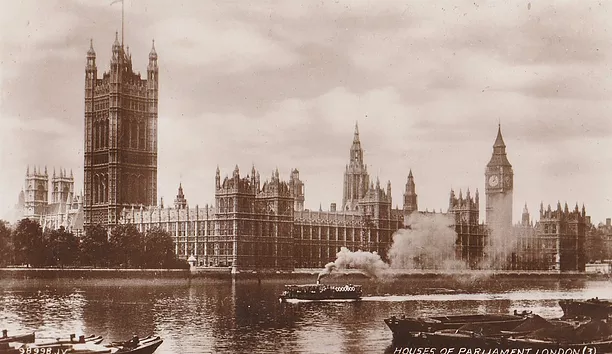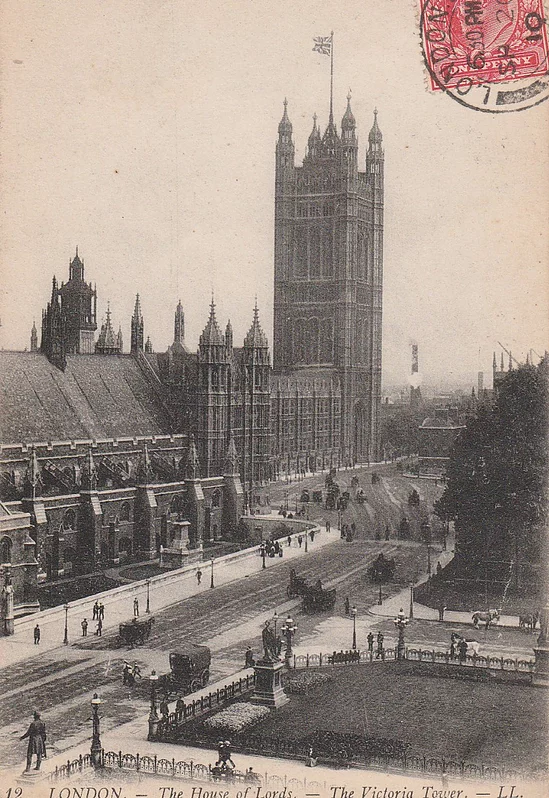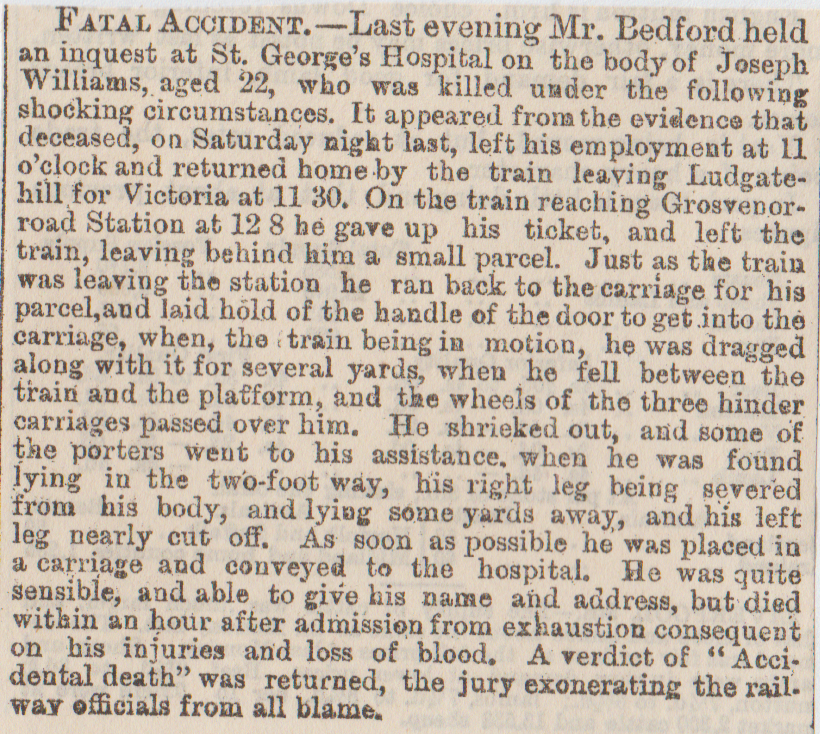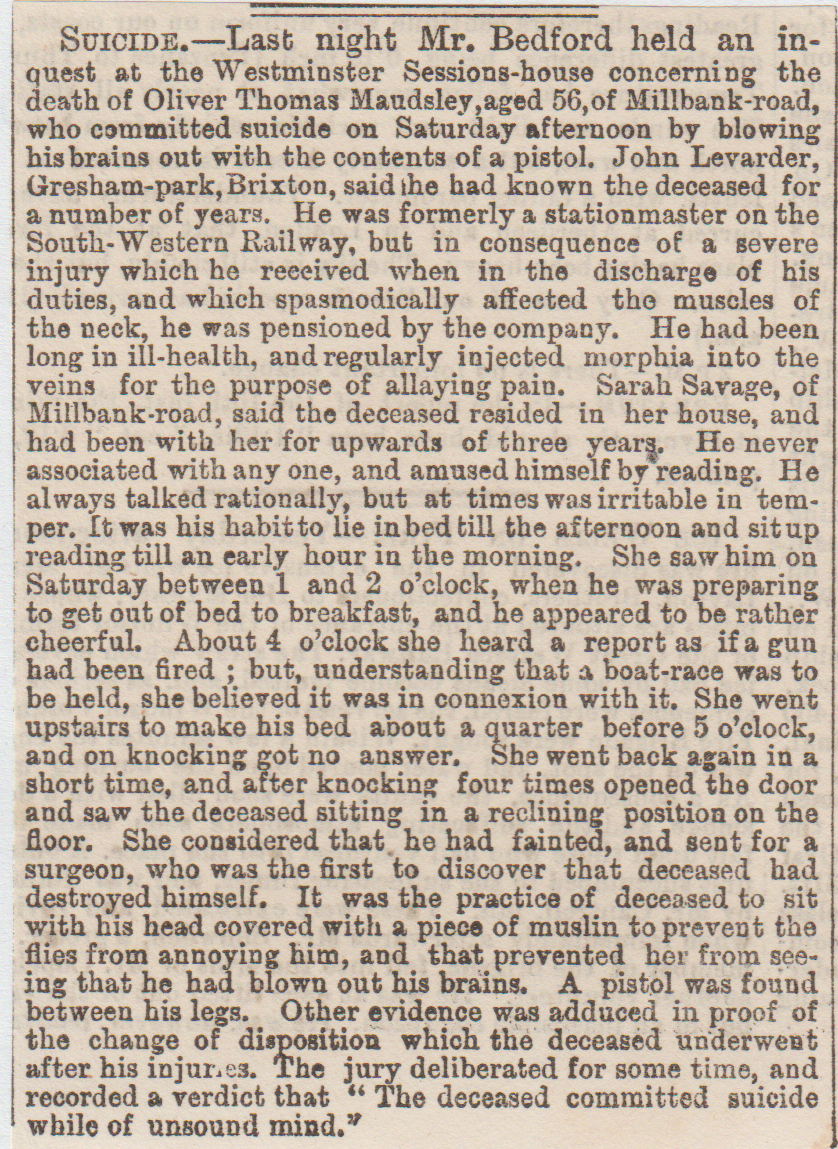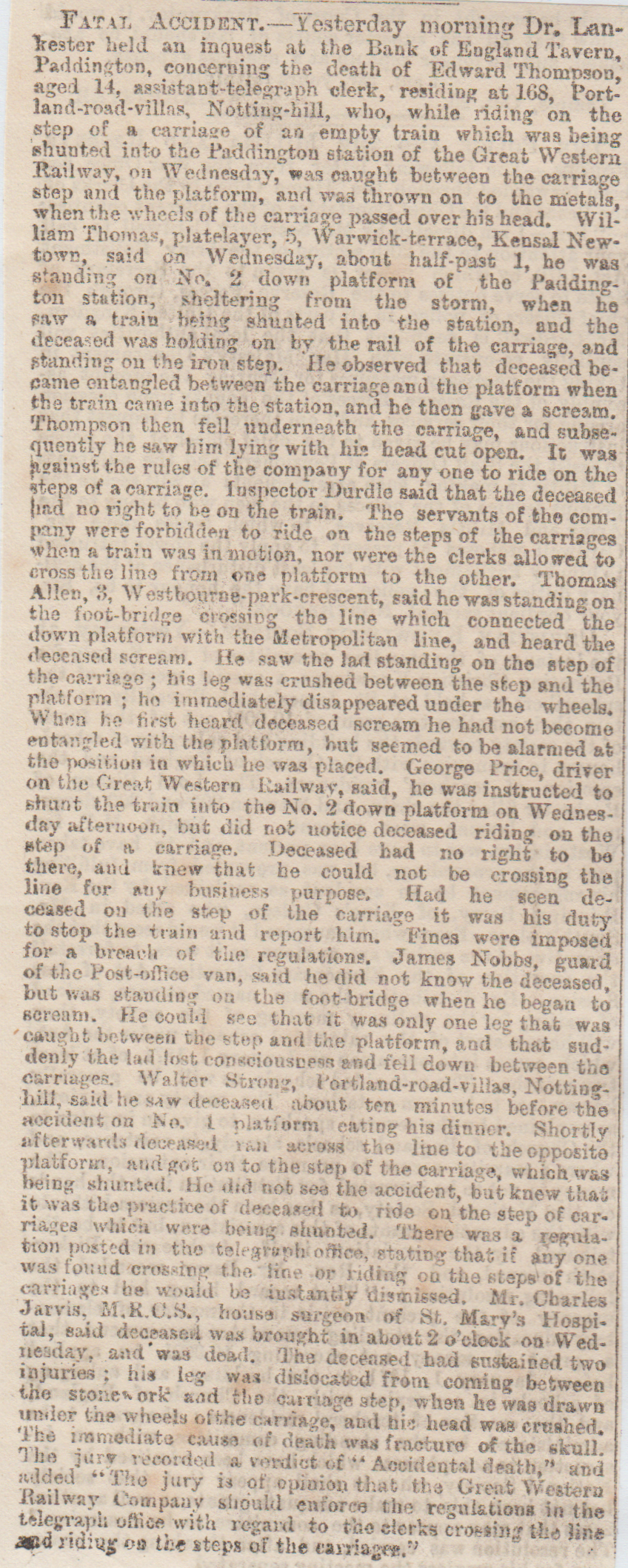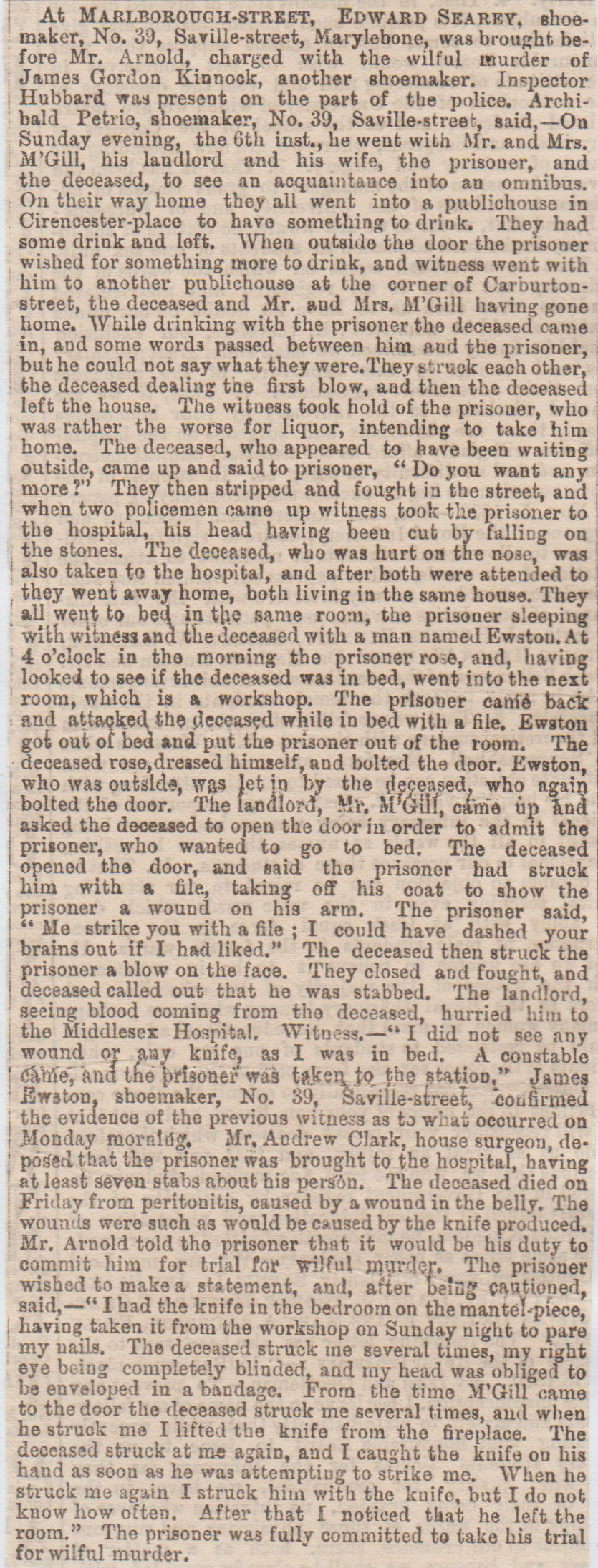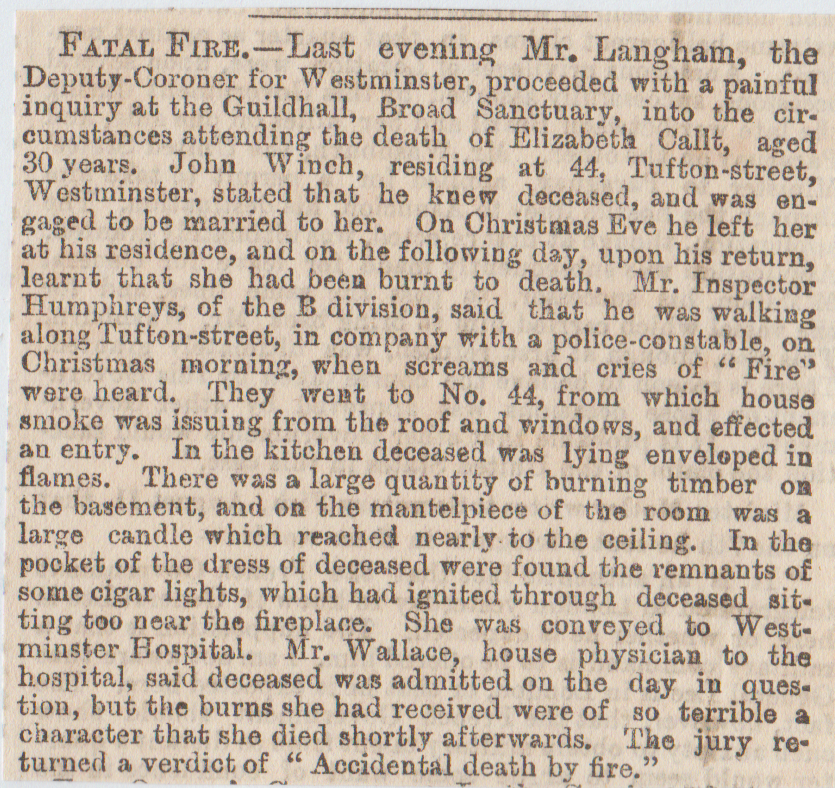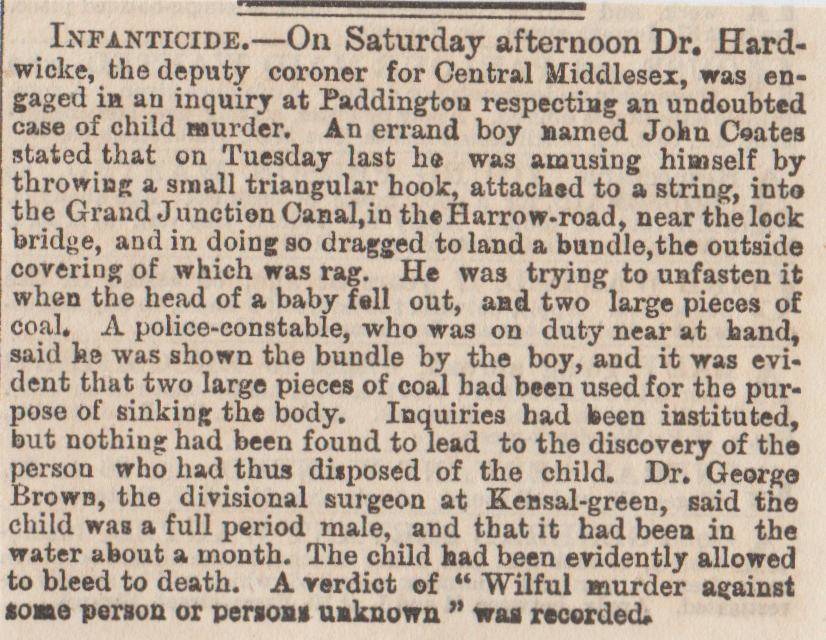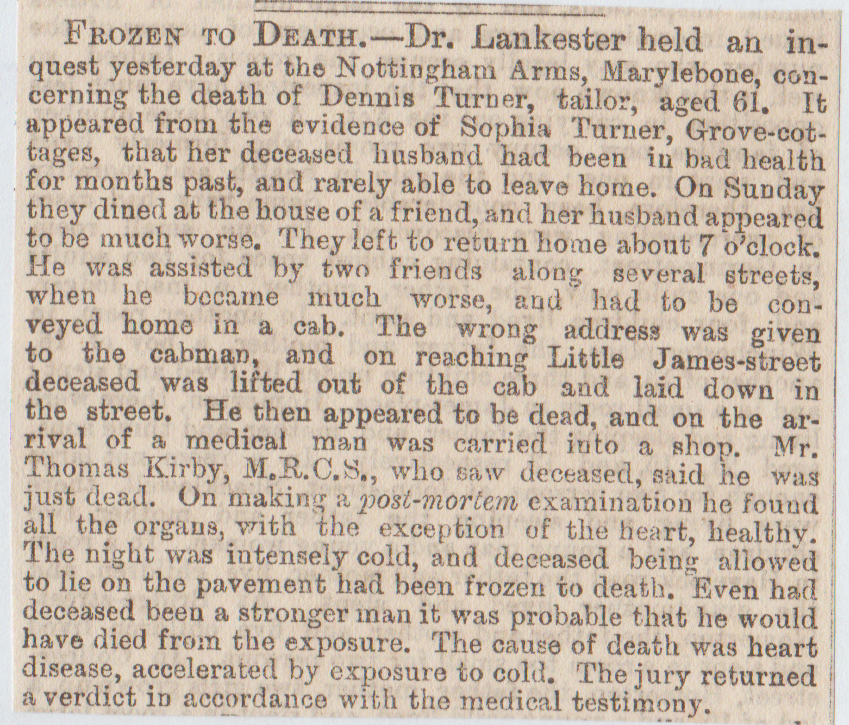1/ Drury Lane Theatre Death, Covent Garden, July 1883
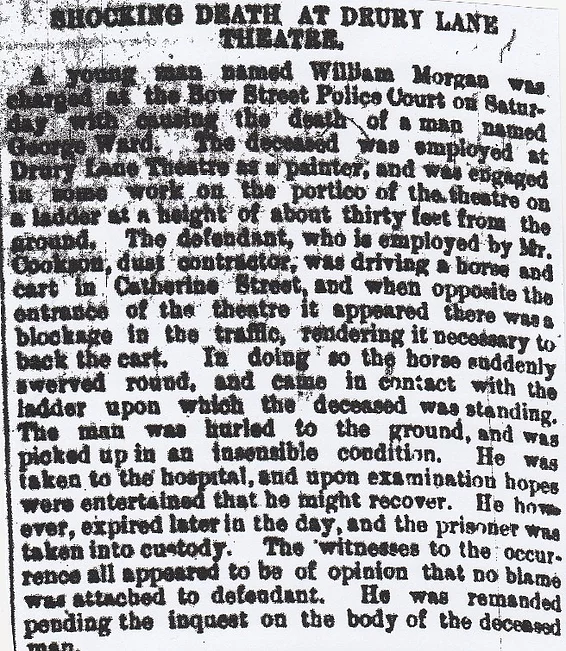
2/ Scotland Yard, (Superintendent Kills Himself) March 1896
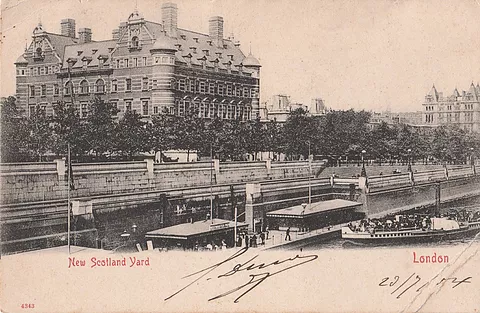
Superintendent of New Scotland Yard has committed suicide at his residence at Stockwell, by shooting himself with a revolver. Mr Cutbush was also resigning his post as Superintendent. At present no reason is assigned for the act.
3/ Hotel Cecil Suicide, Strand, September 1915
Private John Halt was found in a bedroom at the Hotel Cecil with a gunshot wound to the temple, suspected attempted suicide. He was a member of the Army Veterinary Corps and came from Oxfordshire. (Did he live?)
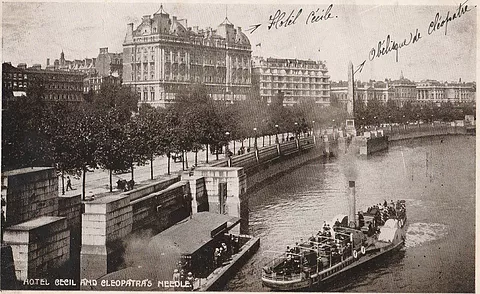
4/ Hotel Cecil Poisoning, November 1896

5/ Foreign Office Suicide, October 1894
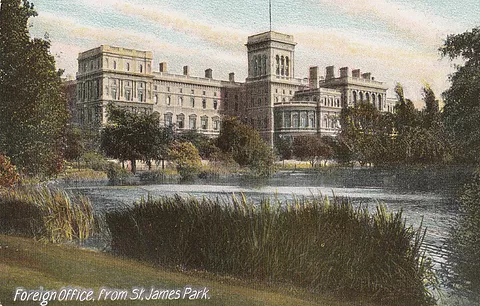
Mr Patrick Henderson was the British Consul in Cadiz in Spain. A friend at the inquest said he was fifty-two-years-old, not in good health, who had heard him threaten suicide quite a few times. Henderson was prone to hysterical outbursts and one of these occurred one day when a Mr Foley came to see him in regard to a letter he had written to him on behalf of Lord Kimberley about an appointment which Henderson wanted to obtain..Foley said he couldn’t get the said appointment, to which Henderson replied: “There’s but one thing for me to do”. He then began to laugh hysterically then started sobbing, Foley turned away for a moment, then he heard a gun-shot. He saw Henderson on the floor with a hole in his head. Apparently, he had sort of planned his suicide because he left a note in his pocket addressed to the coroner- it partly read:
“God help my poor children; they are orphan’s, friendless in London. I enclose a sovereign. It will pay their cab fare to Barnardo’s or an orphan asylum. God help my poor children. PATRICK HENDERSON”
Death was obviously due to a self-inflicted gunshot wound, but the note about being poor and orphans was a load of crap. He had money and property, as you would expect working in the Foreign Office. (Does his ghost roam the halls of the F.O.?)
6/ No.11, Regent Gardens Wife Murder, October 1888
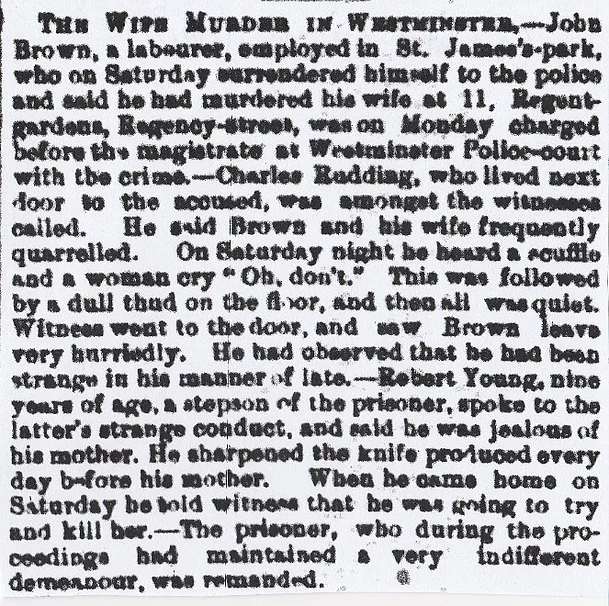
7/ Great Western Hotel Suicide, Paddington, January 1903 (Is it now the Hilton at Paddington?)

8/ Marylebone Shooting, August 1890
At the Old Bailey on Monday, Francois Manteau aged fifty-one was sentenced to death for shooting Francis De Grave in Marylebone. Prisoner and deceased were Belgians, and the prisoner was jealous because a woman named Dupont, who came from Belgium left him to live with the deceased.
9/ Buckingham Palace Suicide, November 1837
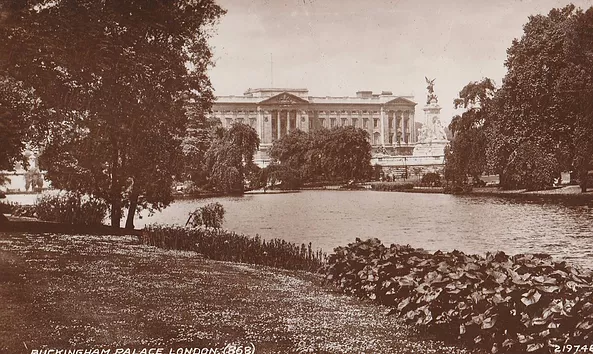
Henry Fricker, who for thirty years was a footman in the royal household, decided suicide was the best way out and hung himself in one of the harness rooms. He tried to kill himself first by hanging himself with his handkerchief, but that failed when he tore it due to his weight. Fricker was one of the oldest servants working there. He was the driver for George IV (1820-1830) and also to William IV (1830-1837) and Queen Victoria was just pronounced Queen in 1837.
Later on in Victoria’s reign, another of her footmen would kill himself at Caxton Street in Westminster at the Town Hall Chambers. Charles Pammel Ambrose aged thirty-one, whose father also works in the Royal household at Windsor stables, said his son had never had suicidal tendencies. He was told to go and wait on a table but didn’t. His superior gave him a good telling off and said he was being reported. This is surely the only thing that could have triggered his suicide attempt.
10/ Houses of Parliament Death, November 1854
The Victoria Tower is the big one on the left-hand side and the Elizabeth Tower is the one with “Big Ben” in it. A twenty-eight-year-old carpenter named George Wright was fitting a piece of wood into one of the windows of the Victoria Tower when he lost his footing and fell over eighty feet and fell on an iron-beam. He was instantly killed and left a widow but no children. The Tower itself is over 320 feet high, so he was only about a quarter of the way up it and I presume, it was inside.
11/ House of Commons Fatality, August 1853
In the lobby of the House of Commons, was where Henry Bellingham shot the British Prime Minister, Spencer Perceval in 1812. This was the last time that Britain had a Prime Minister assassinated, so there has been a murder in there! This little story is about an old lady involved in a singular accident. The lady, named Sadler, from Eubury Street in Pimlico went on a tour of the Houses of Parliament. She was going up the stairs leading to St Stephen’s Hall when a door swung back and smacked her full in the face and she fell to the floor. The old dear was rushed to Westminster Hospital but she died shortly after.
12/ House of Lords Fatality, March 1834
This is regarding the sad death of the housekeeper of the House of Lords, Mrs Jane Oakleyaged seventy-eight, who lived on the premises and provided the MP’s with food and drink and kept the place tidy. Early one morning her body was discovered at the rear of the House of Lords, lying dead on the floor with a fractured skull, with fractures in both legs and a simple fracture of her thigh as well. Evidence suggests that she fell from a gallery (Approx.50 feet) while trying to water some flowers. (Does she haunt the House of Lords?)
13/ War Office Suicide, November 1860 (The one on the left)
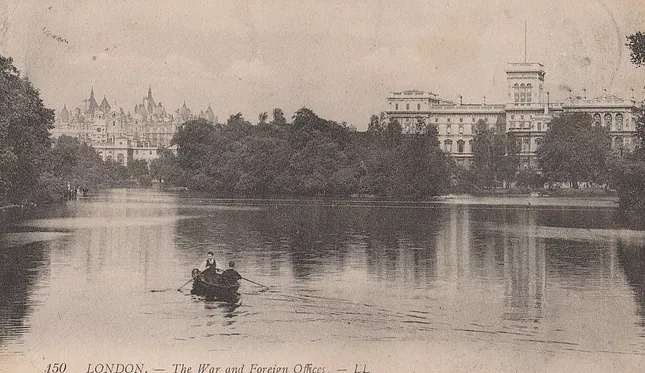
On the premises of the War Office in Pall Mall, a messenger by the name of George Stiller killed himself by hanging. It was in a part of the building known as the “lower back room” and he was found hanging from one of the book-shelves. They tried to revive him, but sadly he was already dead. He had managed to hang himself with a thin piece of string, which was tied to the book-shelf and passed through an opening that was used to brush the dust through. (This postcard was early 1900’s and the War Office moved to Cumberland House, Pall Mall, for the last half of the 19th Century)
14/ Charing Cross Station Suicide, August 1869
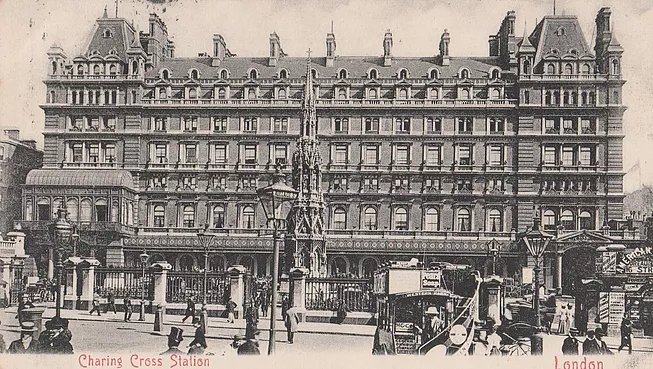
Looking at the above postcard from 1905, the suicide in 1869 jumped from one of those windows. One Saturday afternoon a man threw himself from the balcony in front of the smoking saloon which overlooks the interior of the station and onto the platform below. He expired on the spot, with his head being smashed to atoms. A letter found on his person suggests that his name could be Captain Frederick Bowker.
15/ Charing Cross Station, February 1882 (Dead child found)
A deceased baby boy was discovered in the waiting-room at Charing Cross Station. A plumber named James Pontie was checking the plumbing in the toilets at the waiting-room when he found the child, stark naked and forcibly wedged into the place he was found. The little chap had been there all night. The surgeon revealed that three of his ribs were broken and had a laceration on his side. Apparently, he believes that he never breathed at all as his lungs weren’t expanded.
16/ Charing Cross Station Underground Fatality, May 1899
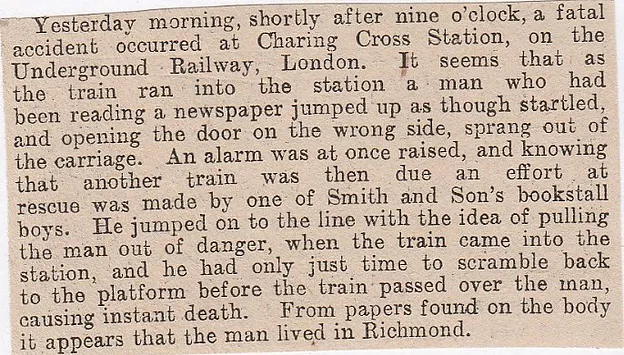
17/ Charing Cross Station Suicide, May 1867
A water closet door had been closed for ages and when an attendant tapped on the door to get a response and received no reply, they broke it down. The found a fully-dressed gentleman sat down, but not moving and with no blood anywhere. A stomach pump was used on him and lots of laudanum was drained out, but it was too little too late. In his pockets were four bottles marked “Laudanum” and a few betting slips on him as well. The suicide had written to his parents before he did this, stating his intention to kill himself and they later turned up at the hospital to identify the body.
18/ Trafalgar Square/Nelsons Column, September 1852
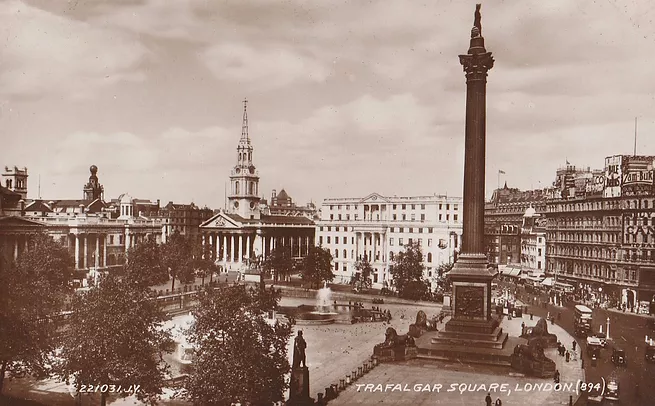
As you can see in the above postcard, at the base of Nelsons Column just above the steps are giant bronze tableau’s, and it was a workman putting one of these into place that ended up with him dying horribly. The man’s name was Daniel Allmond and he was with a group fixing the bronze into place, the one on the west side facing Cockspur Street (if you want to see it) and the bolts were being fastened in with molten lead, with Allmond manoeuvring it into place. It was about twelve pounds in weight and it was after ten pounds had gone when a noise was heard and the molten lead fell on him, straight into his face and mouth. He was horrifically burned and rushed off to hospital. It was thought that some water in the cavity, met with the boiling lead, causing the instant steam power to cause a mini-explosion. Allmond’s sight was partially gone and his face will be the scarred for life.
19/ Trafalgar Square Riot, December 1887
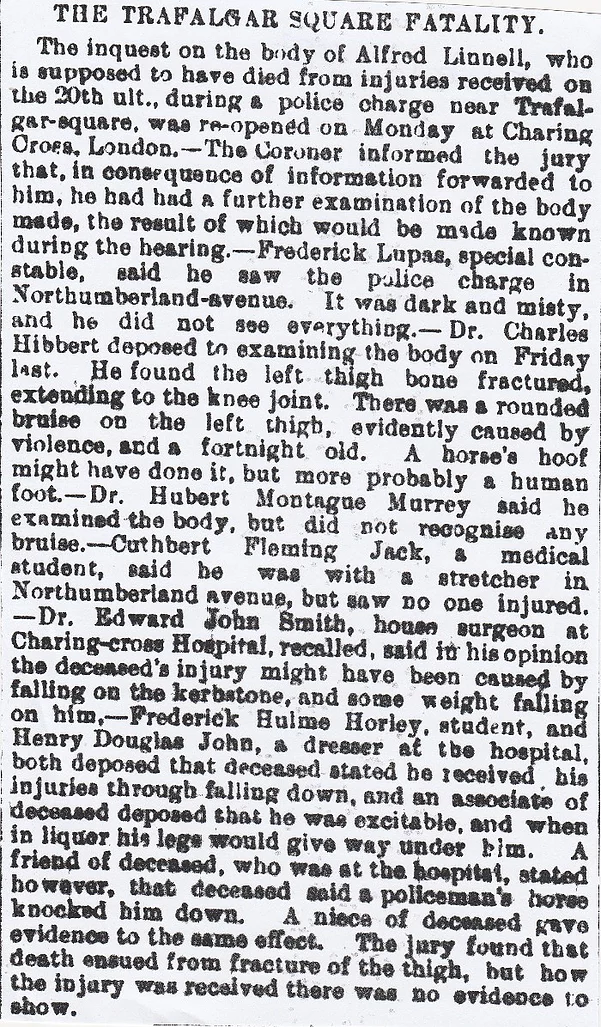
20/ Horse Guards Suicide, May 1852

A suicide was carried out by a Grenadier at Horse Guards by slitting his own throat. He had been on guard duty all night and was relieved from duty in the morning. He went to have a nap in the “Black Hole”, which was normal practice for the soldiers when there were no prisoners in confinement. He was not seen for ages and when someone went to get him, they found his bed drenched in blood and him with his throat cut from ear to ear. Medical assistance was procured but he’d been dead for quite a while. (Anyone know his name?)
21/ Paddington Green Police Station Suicide, December 1888
On Christmas Day a woman entered the Paddington Green Police Station and in an excited manner told the inspector on duty that she had taken poison. The divisional surgeon was at once sent for and on his arrival gave the woman an emetic. She, however, died within a few minutes. She has since been identified as Elizabeth Foulkes, a housekeeper to a cab proprietor.
22/ Carlton House Terrace Lift Death, (near Pall Mall/Trafalgar Square) May 1902
The inquest began on the death of the housemaid who was fatally injured by the luggage lift at 18, Carlton House Terrace. She had placed the breakfast articles in the lift, then started it to go up another floor, when her chin got wedged and drew her into the lift-shaft and she was hung by the neck. The poor woman literally had the life throttled out of her.
23/ Marylebone/Westminster, June 1843 (Three Wives Married to One Husband Commit Suicide)
The inquest was held at the Seymour Arms in Bryanston Square, so I presume that it was nearby, that all this happened. Forty-four-year-old Mary Salmon had left her husband and had lived a crappy existence, so she took some laudanum. Not an unusual story you might say, but Salmon was the fourth wife of the husband and another two of them had also committed suicide while with him.
24/ Stanhope Street, Euston Road, February 1899
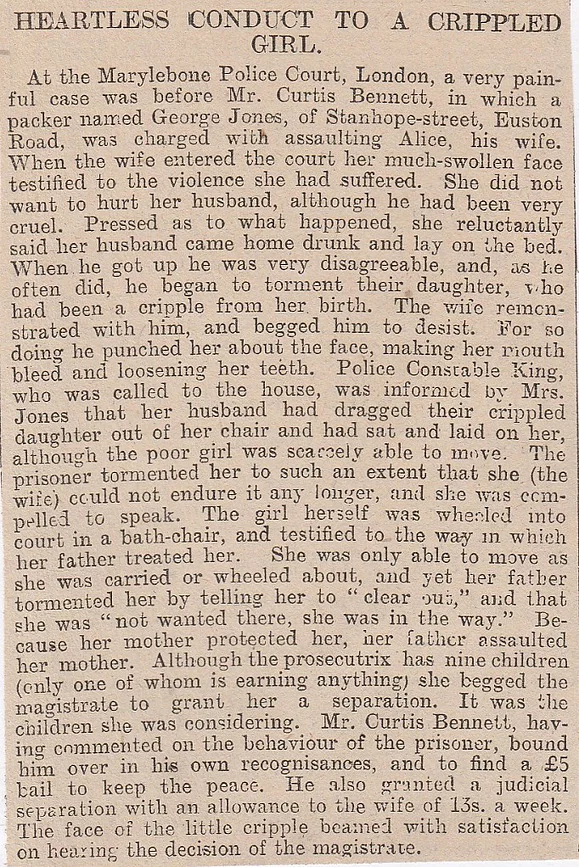
25/ Portland Place, Marylebone, (Child Corpse) December 1878
The corpse of a baby girl was found in the gutter at Weymouth Street, Portland Place. The face and body were mutilated and its legs had been tied together with twine. It was wrapped in a man’s shirt and police are trying to find the perpetrators of the crime.
26/ Crawford Street Suicide, Bryanston Square, July 1835
A seventy-two-year-old servant to Miss Smith, of 129, Crawford Street, named Elizabeth Burrows, committed suicide. She had been in their service for twenty years but had been given her walking orders, making her ultra depressed. When she was in the locality, she told a pin-cushion seller that she was going to end her life by drowning herself. She went to bed as usual and when a family member entered her room the next morning, she saw a pair of feet sticking out of the cistern. The thought of losing her job had been the sole reason for her committing suicide. (129, Crawford Street is still there, now a photo business).
27/ Connaught Terrace Suicide, May 1836
This is the suicide of one the upper classes of Victorian London society. The Honourable Berkeley Craven aged sixty, killed himself at his home in Connaught Terrace in Paddington. His losses on the Derby were an estimated £30,000, which is a huge amount today let alone one hundred and eighty years ago. Understandably he was slightly perturbed by losing such a vast amount and he was left alone to calm down. A servant found him lying prostrate in the parlour at six a.m., with a pistol in his hand and a gaping hole in his head.
28/ Portland Road Station, June 1888 (Re-named in 1917 to Great Portland Street Station)
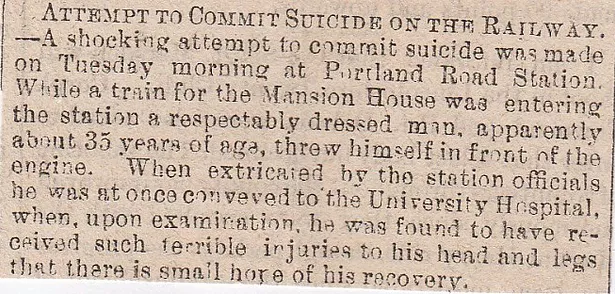
29/ Burwood Place, (Theft while Dying) February 1854
A dreadful accident happened to Mrs Goddard of Queen Street, Edgware Road, Paddington, when she was crossing the road near Burwood Place and collided with an omnibus, with the wheel of it passing over her head. Understandably, she never survived the accident but the gold watch that she wore, was nicked by some ruffian who pretended to be helping her.
30/ Soho Square Suicide, March 1845
The inquest was at the Cock Tavern in Grafton Street off Soho Square, so I presumed it was somewhere nearby. It was concerning the death of Sophia Margaret Thompson, a thirty-six-year-old cook, who poisoned herself by taking essence of bitter almonds, which is used to flavour cakes and puddings. The reason for the suicide was the most common in all of Britain and that was that her fiance had dumped her.
31/ Bedfordbury Infanticide, Charing Cross, September 1901
In the early hours of the morning, a salesman killed his two-year-old son while his wife was out of the house. This happened at No3, Bedfordbury, and had several cuts gashes around the face and had its throat slit. He was arrested at the scene of the crime. He was John Thomas Richardson aged forty-one, a salesman in Covent Garden. His excuse was that he did it for the child’s own good, also stating that he had a nerve. He bit the child’s mouth and head and a policeman found a piece of the infant’s lip at the crime-scene.
32/ Church Street Fire, Soho, April 1899
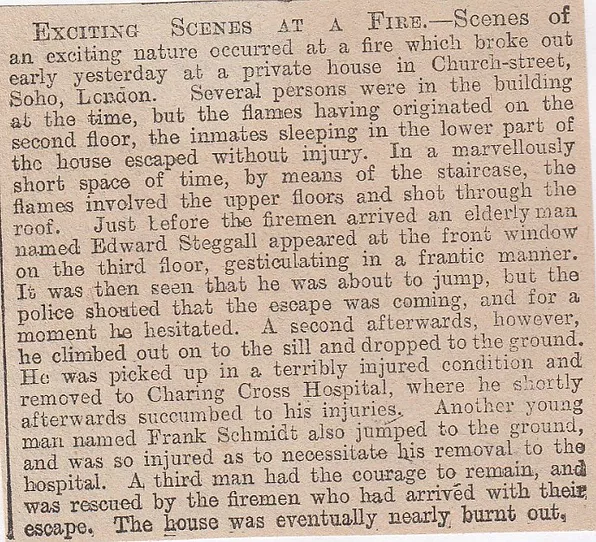
33/ Grosvenor Hotel Suicide, December 1910 (Announces His Own Death)
It could have been a scene from an Agatha Christie novel. Mr John Scott from Worthing in West Sussex aged fifty-nine, who was an agent for a metal firm, checked into the Grosvenor Hotel and shot himself while there. He wrote his own obituary, which he had published in various papers. He was thought to acting weirdly at work, he was up S**t Creek as far as money was concerned and asked friends and family to lend him some cash, but to no avail. He left a letter for the coroner, saying that he was worried and also his sight was fading fast.
34/ Baker Street Station Suicide, February 1910
An elderly man threw himself in front of a passing train at Baker Street Station and was instantly killed.
35/ Baker Street Tunnel Suicide, April 1895
One morning on the Underground Railway near to Baker Street Tunnel, a smartly dressed gentleman was discovered. He was sliced into two by the rails and wheels of one of the engines running over the body.
36/ West Street Fire, Soho, March 1899
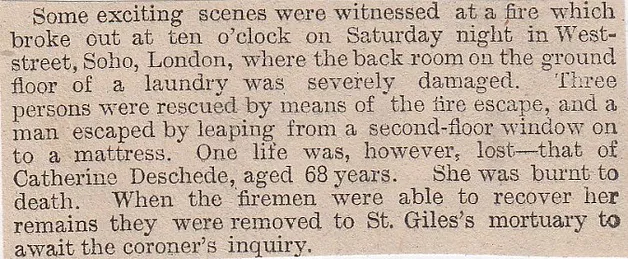
37/ Metropolitan Music Hall Suicide, Edgware Road, December 1885
This is an amazing story of a suicide during a performance. The man in question was Thomas Arring, who was a footman to a posh family in Cavendish Square. As the people were watching the act, Arring pulled out a gun and pointed it at his forehead, then as spectators tried to stop him, he pulled the trigger. The women were greatly distressed by what they had witnessed.
38/ Pimlico/Yalding Child Murder, February 1882
At the end of December in 1881, a little girl named Georgina Moore vanished from her house in Pimlico. She was only seven years of age, with blond hair, dark clothing and white straw hat on. A body that fitted her description exactly was dragged from the Medway at Yalding in Kent. There were strangulation marks around the neck and the body had a firebrick attached to it with wires.(Was it her body?)
39/ Harrow Road, Paddington, (Human Head Found) May 1875
A human head was found in a dust-heap next to Chippenham Road off Harrow Road. Basically, it is a refuse tip or small land-fill area, and a cart was dumping off some garbage when some children, who sifted through the rubbish found a parcel of rags. They undid the rags and a human head dropped out, still bleeding and fresh. Thank God there was a logical explanation for this, and police found out that it was to be used in a dissection at University College Hospital and had been mistakenly thrown away.
40/ Blenheim Terrace, St Johns Wood, (Attempted Murder/Suicide) August 1905

41/ Hamilton Terrace, St Johns Wood, (Cook’s Body Found) August 1891
A cook had been missing from No 3, Hamilton Terrace in St Johns Wood and no trace of her was ever found in the neighbourhood, but a couple of days ago the mistress of the house was looking out of an upstairs window and thought she saw something in the cistern. When it was checked, it was found to be the decomposed remains of the cook who had been missing for ages.
42/ Coburg Row, November 1891
A baby girl was discovered buried in the front garden of a house at Coburg Row in Westminster. The much-mutilated corpse of the infant belonged to Richard Bennet, a stableman and Maria Tickridge, a house-keeper. They maintain that the child was stillborn but the state of the body leaves that theory open to debate.
43/ Paddington, January 1866 (Double Suicide)
Normally when you see the phrase “Double Suicide” it is usually a couple of love-sick teenagers who think they can’t live without the other, but this is strange because this is a mother and son suicide pact. A Frenchman named DeCalnive, apparently some sort of French nobleman, and his Mum, rented an apartment and had people come and visit but they never paid the rent to the landlady. She gave them notice to quit but let them stay another night as they had nowhere to go, then the next morning when she went to turf them out she found them both hanging from either end of a “cornice-pole” (I think this could be curtain rail?) They had premeditated this and had left letters, both stating how they wanted to be buried.
44/ Adelphi Theatre Assassination, December 1897
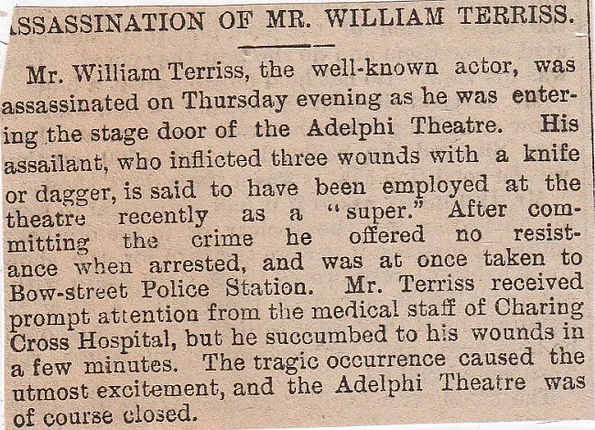
45/ Ritz Hotel, (Arches Death) December 1910
An unknown man died suddenly in the colonnade of the Ritz Hotel. Apparently, the Ritz Arches are a gathering place for the homeless and tramps, and in the early hours of the morning, the window sills were used as benches.The Coroner said: “I don’t suppose it was built for that purpose. A comfortable resting place for tramps- the Ritz! ”
46/ Windmill Public House Suicide, Windmill Street, Mayfair, July 1865 (Pub Suicide)
William Braddock aged thirty-four, a man who had lost his marbles but previously done a lot of his army service abroad, was discovered in a closet at the Windmill pub in Windmill Street. The pub is still there. He had slit his throat with a knife, which was by his side.
47/ Great Windmill Street, Soho, (Female Body Parts) December 1900
On Christmas Day in the seedy streets of Soho, a butchers assistant was cleaning out a cart in Hamyard off Great Windmill Street when he discovered a brown paper parcel. He opened it and found it contained a piece of a female’s body. Police were called for and the grisly remnant has made its way to the mortuary for analysis.
48/ Suspension Bridge Suicide, Pimlico, May 1858
The bizarre tale of a Chelsea pensioner who trundled over the new Suspension Bridge at Pimlico and then threw himself into the River Thames. He was swept away by the current before he could be helped. The Royal Humane Society dragged the river-banks and his body was found later on that afternoon.
49/ Empire Hotel, (Leicester Square) April 1892
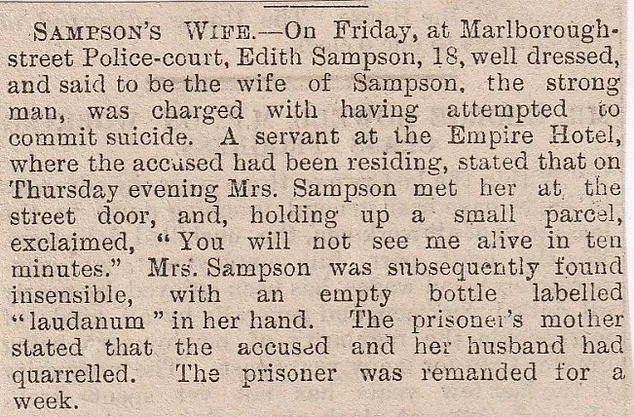
50/ Soho, November 1893 (Choked on a Billiard Ball)
A strange accident occurred at a public-house in Soho when a group of blokes were in the billiard room, when one of them fuelled by drink, thought it would be a great idea to shove a billiard-ball in his gob. He’d done the trick before but on this occasion, it went horribly wrong and it became lodged in his throat. He was whisked off to the hospital in a cab but died on the way.
51/ Grosvenor Gardens Infanticide, Eaton Square, April 1876
This gruesome discovery was made at the mansion of Sir Lawrence Palk, No 1, Grosvenor Gardens in Eaton Square. A domestic servant found a package wrapped in paper and told the milkman, then he got a copper to open it and inside was a newly-born child, dead as a dodo. A housekeeper to a gentleman in Bayswater thought that the eighteen-year-old housemaid looked pregnant shortly before going on holiday. When she got back she was questioned and it turned out that she was correct. She had given birth to the child, then wrapped it in the parcel and thrown the infant into the area where it was discovered later on.
52/ Morley’s Hotel Suicide, Strand, August 1892
The suicide of a General at Morley’s Hotel got the staff and customers in a frenzy. The suicide was that of Brevet Brigadier-General Henry Prince of the U.S.Army. Long since retired, as he was now eighty-two years of age, shot himself in the temple. He left a letter addressed to “All my Friends” stating in it that he was going to shoot himself and it would be “A relief which ought to be brought about by the physician when the life of an individual became wasted by nature”. You can go to Dignitas in Switzerland now, if that’s what he meant!
53/ Stockbridge Terrace,Pimlico April 1892 (Over-enthusiastic with scissors!)
The first line reads;-A fire resulting..
early on Tuesday
Stockbridge Terrace
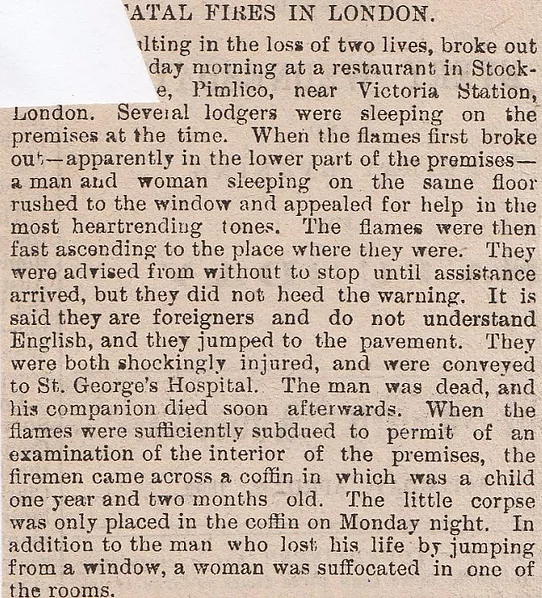
54/ Eccleston Square, Belgravia, (Corpse in Cellar) January 1880
Labourer John Lacey was working at a house in Eccleston Square when he had to make a trip to the basement area, which at one time was a coal-cellar. While down there he thought that he spotted a coconut and pulled it out, only to find that it was a human skull. Police were draughted in and a search of the cellar led to the discovery of the skeleton. The position the body was in leaves no doubt that someone bent the body in half to make it fit into a small recess down there. The vertebrae were doubled over and the thigh and arms had been broken. Police examination revealed that the body was not an adult, but that of a teenager. The family had lived at that property for seven years and had complained about the awful stench on a regular basis.
55/ Temple Station Suicide, March 1875
Not a very salubrious place to breath your last, in a bog at a train station, but this guy had problems. George Richard Moyes aged fifty-eight, had been the cashier at solicitors in Gray’s Inn for thirty years and was, some would say, a workaholic. He was methodical in the workplace, hardly ever took a holiday, but recently had been showing signs of mental aberration. This could have caused him to go into the toilets at Temple Station and blowing his brains out.
56/ Princess Theatre Suicide, June 1857
The glass-collector, Joseph Gallick, who worked at the Princess Victoria pub on Castle Street, off Oxford Street, would tidy up the glasses and pots left in the Princess Theatre also. When two members of staff entered the Theatre later on that morning, they discovered him hanging by a rope. No reason for the act can be assigned.
57/ Lees Street. Piccadilly, January 1885
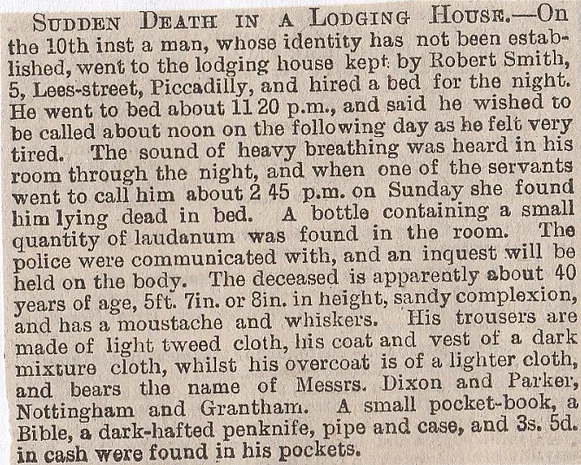
58/ Danish Embassy? No 39, Grosvenor Place, December 1833 (near to Buckingham Palace)
When it says that the Danish Minister’s establishment, I presumed it meant the Embassy, but could be private living quarters. The body of Dorris Jessin, a twenty-nine-year-old nursery maid was found in Beron Blome’s (Danish Minister) establishment. Late on one evening, a staff member noticed some kind of liquid trickling under the door of the dining-room. When they opened the door, Miss Jessin was sprawled out on the floor, with her throat cut and the razor by her side. She was already dead. Miss Jessin was also found to be pregnant when the autopsy was performed, with the father unknown. Back in Denmark, she had two illegitimate children, so she had a bit of a history of this type of thing. Other staff members had found her on her own and crying, on many occasions. (Could the Danish Minister have been the father?)
59/ Harley Street, (Human Remains in Cellar) June 1880
No 139, Harley Street, the property of Mr Enriques, has been the scene of great excitement in the locality when human remains were found in the cellar. They are of a female about forty years old, with decomposition so bad that her facial features are unrecognisable. There were various articles with the corpse that may prove useful in identifying her, but one strange part of the case is that her hair had been cut from the head and she had burns all over, from the quicklime she had been buried in. The cask she was in, is an American meal tub and was covered in lumber. (Was the identity ever discovered?)
60/ Little Marylebone Street, Marylebone, March 1897 (Childs Body)
While the workmen were busy demolishing some houses in Little Marylebone Street in Marylebone they stumbled across the dead body of a young child. It was badly decomposed and was thought to be aged about seven or eight years. Also, it was wrapped in a newspaper dated November 1879, so it could have been buried nearly twenty years ago.
61/ Haymarket, (Restaurant Tragedy) June 1888
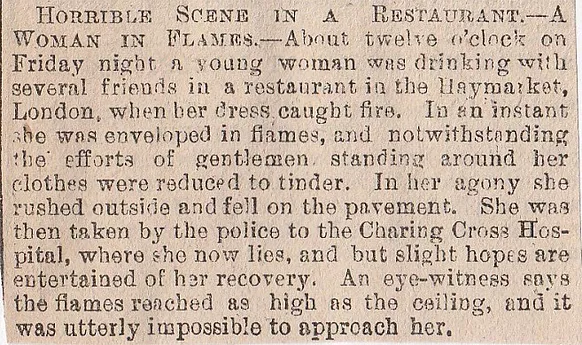
62/ Vigo Street, Soho, March 1885
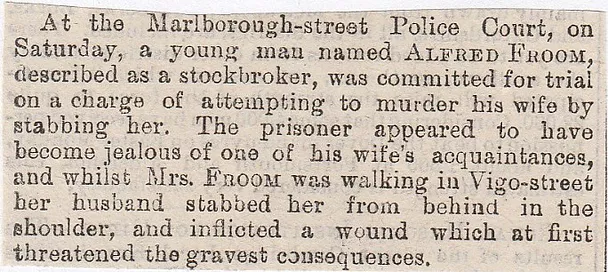
63/ Charlotte Place, Fitzroy Square, September 1850
A restaurant owner (eating-house) in Charlotte Place off Fitzroy Square, committed suicide by drowning himself in a water-butt. He had recently become a gambling addict and had mentioned to people that if “Voltigeur” won the St Leger he would have lost all his money. It did, so he killed himself.
64/ St Johns Wood Suicide, April 1891
John Richard New of 24, Norfolk Road, St John’s Wood, left a suicide note outside his bedroom door for his house-keeper. She went into the room and saw him laid in bed, with a phial (which contained cyanide) and an empty glass on the bedside table. He was inconsolable about the death of his wife and couldn’t get over it. The note read:-
“Dear Phyllis-I do not want to shock you, but be prepared for some very bad news. When you have got this something terrible will have happened to me. Let Mr Houghton know as quietly and quickly as you can. Telegraph to my father to come here, and also Mr Gaskell. Take care of the enclosed key. It opens the drawer in the parlour, where my account books are, as well as my other keys, and some letters.”
65/ Portland St/Baker Street Stations, (Fatal Accident) July 1889
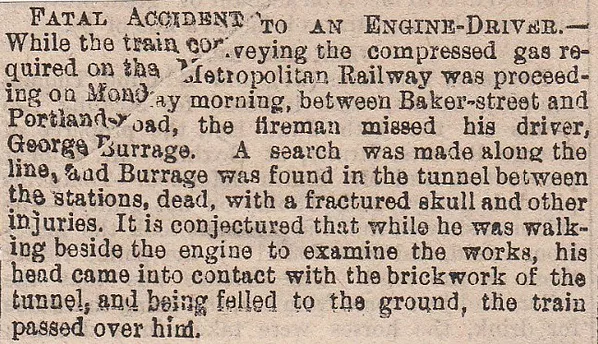
66/ Marylebone, December 1830
14-year-old William Ageat hung himself in his uncle’s stable, when he feared what the consequences would be when he found out that he had ridden his favourite horse and thrown it down, breaking both its knees.
67/ Piccadilly, (Gambling Suicide) September 1848
21-year-old Norman Howard worked in a tailors shop in the West End, but he liked a flutter on the horses so he had money worries. He got into a cab at Regents Circus in Piccadilly, then after a couple of minutes travel, he shot himself in the temple. He had been living up the past few days and had seemed in a despondent mood recently, this was because of his large losses on the horses on the Doncaster St Leger. Similar to Fitzroy Square story above.
68/ Pimlico Pier Child Remains, May 1880
A package was fished out of the Thames near to Pimlico Pier containing the arms and trunk of a five-year-old child. It appears to be the remainder of the body to the head that was found by some lads in Battersea. That was discovered a couple of days ago and the head had curly hair and had been in the river for less than a day. The rest of the body is still missing in the water.
69/ Pall Mall Accident, January 1885

70/ Marshall Street, Golden Square, Soho, (Gored by Bull) August 1839
One afternoon John Williams, a butcher from Marshall Street (next to Carnaby Street), was in the process of “knocking down” a bullock. Being a butcher I think this means to kill it or knock it out! The bull retaliated and its horn went straight through his cheek, just below his eyeball, and tore it to shreds. Chances are that Williams died from the injuries he sustained.
71/ Kensington Gardens Suicide, July 1836
Ralph Worsley, a thirty-eight-year-old who worked for a saddler in Mayfair, drowned himself in the water opposite Kensington Palace. He took out the contents of his pockets and laid them all on the bank. This included a quick suicide note to a friend of his, and it said :
“I have committed suicide in Kensington Gardens. Come as soon as you can, for I prance to the alligators. Farewell, Ralph Worsley.”
72/ Rupert Street Child Kidnap, Soho, September 1885 (Off Brewer St)
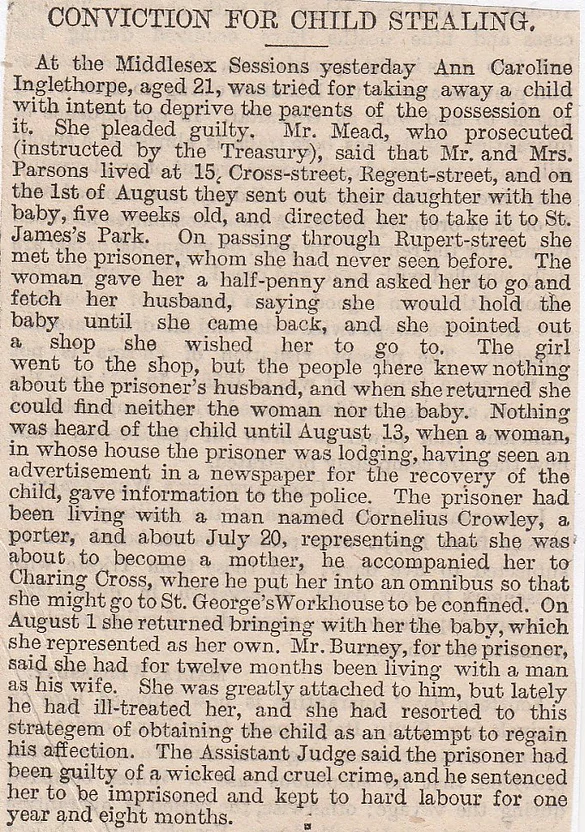
73/ Devonshire Street, Portland Place, (near Regents Park) November 1870
The domestic servant, Miss Sophia Wingfield, committed suicide at 1a, Devonshire Street, by hanging herself from a beam in the kitchen with a piece of clothes line. When they cut her down she was already dead. Interestingly she was sacked from her other job for trying to slit her throat.
74/ No’s 18-20, St James Street, (Hidden Treasure) May 1884
An underground passage was discovered when workmen were digging in St James Street, in it was a strong-box which when opened, was found to contain antique plate, some of it extremely rare. Also among other things were 1700 gold and silver coins and an antique harp, which is considered to be of great value and is at least a hundred years old. (Any more dug up, it says there is a lot more down there in the article?/Passage still there?)
75/ Charing Cross Pier, June 1872 (Dead Match-Girl)
As a London and Woolwich steamboat was approaching Charing Cross Pier, someone on the pier shouted out that something was in the paddle of the steamboat. The captain ordered the bundle to be taken out and it was revealed to be the dead body of a ten-year-old girl. It was taken to the mortuary where an autopsy uncovered the fact that around her neck was a bag containing matches. It is thought she was a match-girl, but how she came to be there was a complete mystery.
76/ Charing Cross Pier Suicide/Lambeth Bridge, January 1890
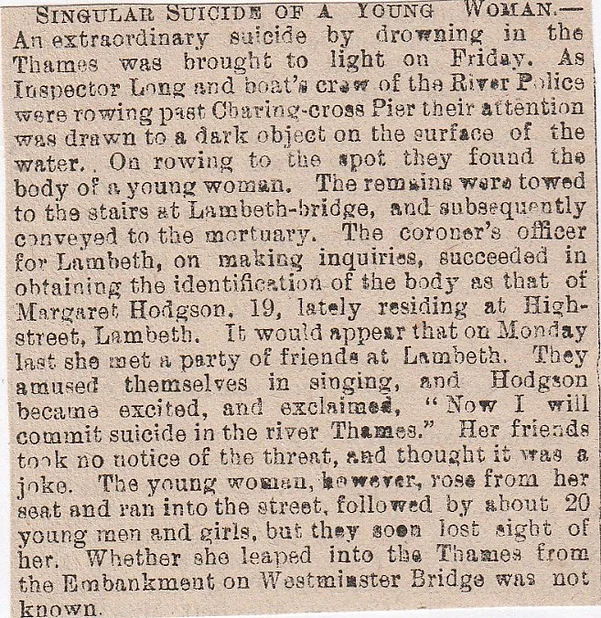
77/ Drury Lane Theatre Fatality, December 1844
A dreadful accident occurred at the Drury Lane Theatre, during a performance of the “Revolt of the Harem”. In the second act of the ballet, the ladies of the harem are found bathing and among those is Zulica, the royal slave. The gas light caught the dress of Miss Webster and she was soon in flames and as she was running about screaming in agony for somebody to help her, she was pushed away by others to prevent them from catching fire. A carpenter on the prompt side of the stage, rolled over her to try and put out the flames. Miss Webster was taken to the Green Room but her burns were said to be life-threatening.
Later on, she died of her burns and Miss Clara Webster, aged twenty-one was buried at Kensal Green Cemetery.
78/ Ebury Street, Pimlico, (Freak Accident) August 1858
This is a million to one accident if ever I heard of one. Sarah Winter, was the cook to Mr Woodly at Ebury Street in Pimlico and she was in the process of hanging a venison in the larder, when she fell from the stool she was balancing on and impaled herself under her chin on a spare meat-hook. She hung there, unable to free herself or indeed to call out. The struggles were heard by another servant and she was rushed to the hospital, but it is said her chances of making it, are slim to none.
79/ Charing Cross Hospital Suicide, September 1906
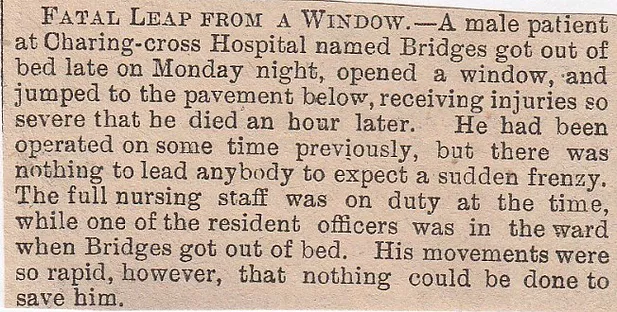
80/ No.18, Grosvenor Mansions, Victoria Street, October 1887
A lady by the name of Witt living at 18, Grosvenor Mansions, threw herself from the top window of the seven-storey building, which is about a hundred feet high. She collided with a balcony on her way down and this deflected her path onto the railings that surround the property. The force of this snapped them in her body and she landed on the pavement. The surgeon who examined the corpse said most of her bones were shattered. Mrs Witt was married to a barrister who was out of town on business. Everybody who knew her said she has been in a really good mood of late.
81/ Royal Orthopedic Hospital Death, Oxford Street, July 1870
Adam Leonard, just a young lad, was sent to the top floor with a pot of tea for one of the patients. On delivering it he made his way down the stairs, when he thought it would be quicker to slide down the bannister. He overbalanced and fell onto the basement floor. There was blood and brain matter coming from his crushed skull and he was pronounced dead on the spot.
(Royal Orthopedic Hospital-was 297-315 Oxford Street, it is still there but now a London gift shop and perfume shop etc.)
82/ Marshall Street Murder/Suicide, Golden Square, April 1885
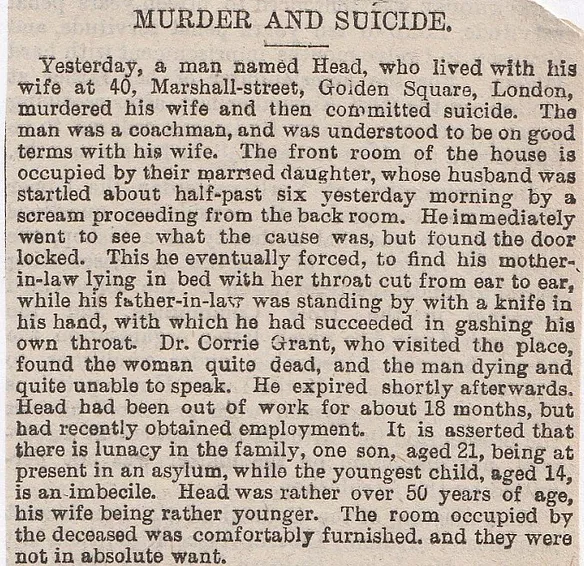
83/ Soho, (Human Body Parts) February 1894
In a yard adjoining St Anne’s School in Soho, a group of school-kids found a brown paper package behind a door. They decided to have a game of football with it and its contents were revealed after a while when a piece of a human skull protruded. Police were summoned and the rest of the parcel was uncovered and they saw two human hands as well as the skull. They are thought to be those of a female.
84/ Little Newport Street, Soho, January 1890
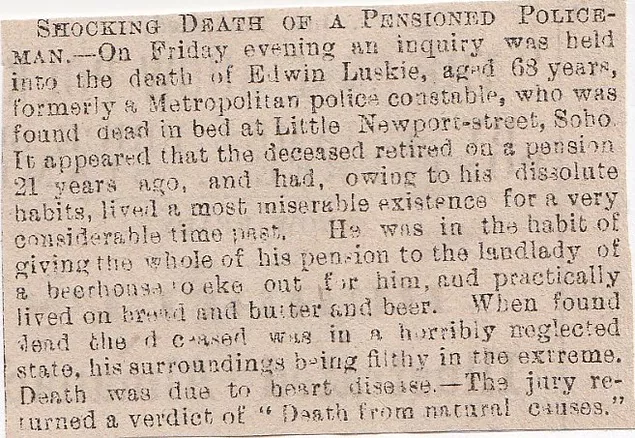
85/ Paddington Station Suicide, May 1873
A gentleman killed himself in a waiting-room at Paddington terminus of the Great Western Railway by shooting himself in the forehead with a revolver. The shot was heard and railway staff rushed to the spot but found the man dead. In his pockets were a handkerchief with the initials “E.P.W.R.” stitched into it and “Major Ripley” on his vest. A check on the Army List revealed a Major Edward P.W.Ripley, so chances are it was this gentleman that shot himself.
86/ No 7, Charles Street, Lisson Grove, (Tragic Accident) March 1835
A man named Crawley who lived at No 4, Oxford Buildings, Cavendish Square, had a terrible accident at his girlfriends’ house in Charles Street, Lisson Grove. He went for a sneaky visit and when finding the door locked he climbed the shoulders of his friend to open the first-floor window. A policeman was on his beat and coming his way, when he lost his hold and fell onto some railings, one of which punctured his thigh and another entered the abdomen. The policeman and his friend managed to remove him from the iron spikes and blood spurted all over the place. He was taken to the hospital, but his chances of survival are slim.
87/ Broad Street, Golden Square, August 1885 (Fatal Ignorance)
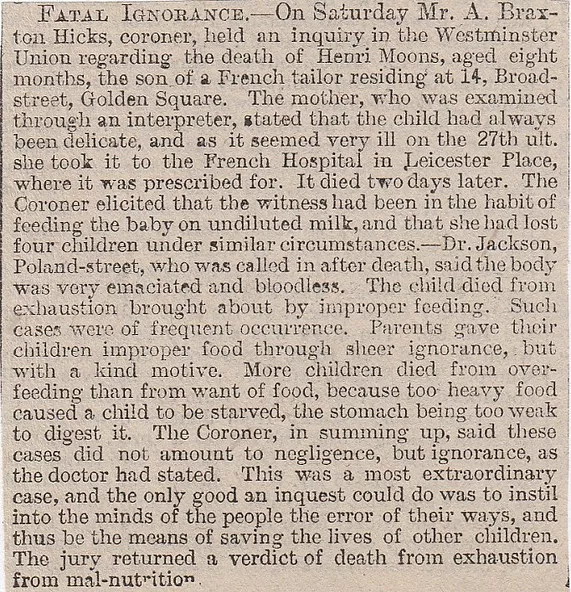
88/ Bow Street Pub Suicide, June 1855
Johnny Broom, a top pugilist, committed suicide by slitting his own throat in the Wrekin Tavern, Broad Court in Bow Street. He had an attack of delirium tremens (the shakes you get when you stop drinking alcohol) and did it in a full pub in the afternoon.
89/ Westminster, July 1917 (Lady Artist’s Strange Suicide)
Doris Church aged twenty-six and a female artist committed suicide in her studio. She was found by a nurse lying on the floor with a gas tube in her mouth. She was rather theatrically dressed in a kimono and her head lay on some cushions which were strategically placed around the room. There was a glass and an empty champagne bottle next to her and also her cigarettes and a pack of cards. The father said she had a neurotic temperament but she was given a generous allowance by him, and her husband who was on the front, also gave her money. The cards were used for a game of patience. She had been treated by her doctor for depression. It is also feasible that she used the cards for fortune-telling. Something happened, whilst also being drunk and highly strung, that made her kill herself.
90/ Barnsdale Road, Paddington, (Orton Mystery) September 1885
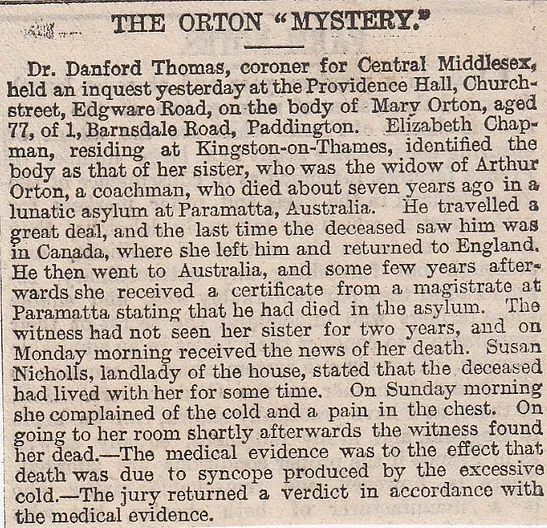
91/ Albion Tavern Suicide, Paddington April 1870
A smart gentleman named Lawrence thought to be from Ramsgate in Kent, committed suicide by shooting himself in the head at the Albion Tavern on Dudley Grove in Paddington. He’d been going there for a couple weeks, drinking and conversing with the locals. When the sound of a gunshot was heard in the pub, the locals and landlord found him lying there with only half his head remaining, while the other half was stuck to walls. He left a letter, addressed to a lady in Ramsgate. It read:
“Hyde Park, April 7th, 1870- Dear Sally, I fired at myself twice last night at Deptford, but missed fire both times, so I must do it tonight in the park, God bless you all. W.L.
It is all through my wife being misled by Tom and others. I knew they meant to get me out. I hope they will always prosper. Mind the children. If the pistol is found I wish Oliver Clarke to have it. Dear Sally, it is now four o’clock. I have just put the cap on the pistol. Goodbye”
92/ Charing Cross, (Child in Parcel) August 1898
Found n the roof of an omnibus at Charing, the dead body of a fully-developed boy which had been born that long. The conductor, Arthur Nice, said that the omnibus arrived at Charing Cross from Cricklewood at midnight and he went upstairs to check the top deck and there he found the brown paper parcel wedged behind a seat. In the package was an alpaca shirt and the child was wrapped in that. He stated that he had not seen anyone get on with such a parcel, but he says it wasn’t there when he checked the top deck at Cricklewood. The coroner suggests that the child should have survived, even being wrapped up as it was.
93/ Westminster Pier/Thames, (Admiral Drowns) May 1888
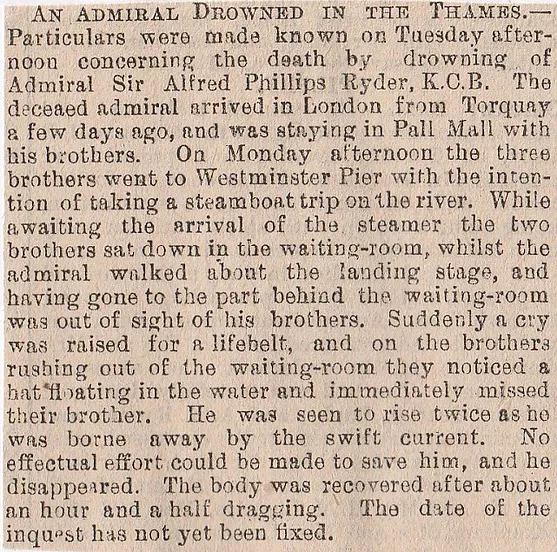
94/ Haymarket, (Dodgy Story about Pregnancy) August 1845
Here’s a sad tale of Emma Whale, a twenty-five-year-old bootmakers wife who lived in Upper Rupert Street, Haymarket. She killed herself by taking oxalic acid. Her husband had left her in Winchester with friends on May 28th, as he had got a job in London. He sent for her six weeks ago and she went down to the Smoke to see him. Several days later it was proved that she had been faithless to him and she admitted as such to her husband. Apparently, she had been coaxed to Portsmouth by a woman named Lynch and as soon as she got there was taken to a pub run by a woman named Day. They had dinner and a glass of wine and then she was introduced to a navy captain, who got her drunk. Emma went to bed when the captain entered her room and had forced sexual intercourse with her. After the sex he told her his name was Edward Stewart and asked her to live with him, then, later on, he would take her to India. He also told her to write to him at “Miss Louisa Edwards, Post Office, Hull”. The husband swallowed the story and forgave her, but the disgrace and gossip preyed on her mind and she thought that suicide was the best way out.
95/ Swiss Hotel, Compton Street, Soho, (Fatal Accident) August 1895
A young lad was walking past Wardour Street when he heard groans coming from the garden at the back of the Swiss Hotel in Compton Street. Police were summoned to the spot and there they discovered a man suspended on some spikes by his arms. He was semi-naked. He was whisked off to Charring Cross Hospital where he died the next day. While in the hospital he managed to tell them his name was Joseph Galvoni and it was established that he had been stabbed, then thrown from the window. He was a waiter at the Swiss Hotel. He had fallen from the fourth storey onto the railings.
96/ Claverton Street, Pimlico, March 1895 (Errant Lovers Suicide)
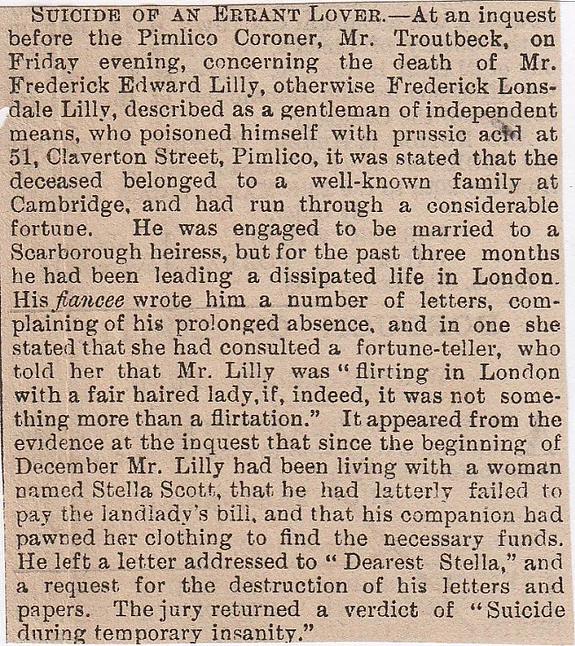
97/ Manchester Square, Marylebone, (Child Remains in Chimney) May 1879
An inquest into the death of a child discovered in a chimney at No 3, Dukes Mews, Duke Street, Manchester Square. The chimney sweep at the property, John Edward Sparks, went up the chimney about two feet or so, in the third back room of Dukes Mews, when the old “brown paper parcel” was spotted. Inside were the remains of a dead child wrapped up in a three-year-old newspaper and the child was barely a skeleton. When the autopsy was performed it was found that it had its skull smashed, but whether this was before or after death, cannot be ascertained. The tenants who lived there said they had hardly used the fireplace it was discovered above. (I believe Duke Mews are still there, off Duke Street, down the side of the Devonshire Arms Pub.)
98/ Bedfordbury, (Boys Body in Skip) October 1881
Ten-year-old Charles Nurse, who resided with his Mum at No 1, Charles Buildings, St Martin’s Lane, was discovered in a dustbin in Taylors Buildings in Bedfordbury. The bin was akin to a modern day skip and was used for the rubbish from the workshops and the brass and copper factory outside whose door it was placed. Police were called for when the lad was found and his body was taken to St Martin’s Mortuary. The surgeon said that he had been dead for a long while. The mother (and this gives you an insight into Victorian parenting), said he would stay away for a couple of days at a time, in a bid to avoid school. It is thought he used to sift around the bins for scrap copper and he might have fallen in accidentally.
99/ River Thames/ Westminster, (Suicide Letter to Son)March 1885
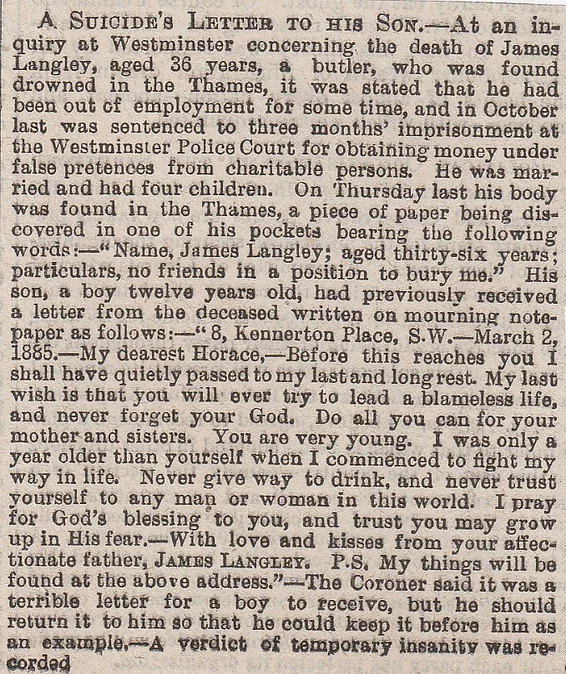
100/ Cirencester Street/Grand Junction Canal December 1860 (Missed Her Brother)
26-year-old single female, Susan Boutcher of No 7, Brindley Street, Harrow Road got some bad news from Jamaica saying that her brother had passed away. At a party at her stepfather’s house, she left friends and family at around one a.m., then was spotted by a policeman running down Cirencester Street (Still there), towards the Grand Junction Canal. The police and family searched the area that she suspected of being in, and sure enough, she was found at the foot of the street where she was last seen alive.
101/ Upper Marylebone Street, (Body in a Trunk) March 1894
A grisly discovery was made by police at Upper Marylebone Street. A slapper from Austria by the name of Hermann, had just moved to the house at the above address and with her luggage was a huge trunk. She used to live at Grafton Street, Tottenham Court Road. The trunk caught the attention of Mrs Hutchins who rented rooms there. Mrs Hutchins said that she came home with an older fella last week and she heard an argument break out between the two of them. The next day there was blood in the sink and then she moved out pretty sharpish. Police searched Hermann’s room, but when asked about the trunk she said it had books in it. They demanded that it was to be opened and when it was, lo and behold, there was the old gentleman with his head smashed in. The body was later identified as that of Charles Stephens of Albany Street, Regent’s Park, aged seventy-six-years-old.
(Upper Marylebone Street-name changed to New Cavendish Street)
102/ Osnaburgh Street, Regent’s Park, March 1899
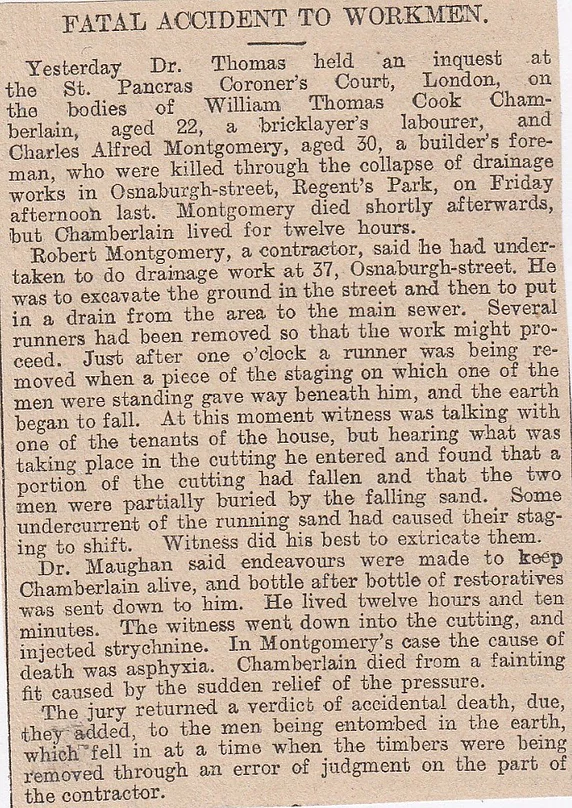
103/ Millbank Prison (Warder’s Suicide) January 1857
John Jackson aged forty-five, head infirmary warder at Millbank prison, committed suicide by taking prussic acid. The medic sent James Higgs, a prisoner, to get Mr Jackson, and when he received no reply to his constant knocking, he peeped his head round the door and saw him lying on the bed. He thought he was fast asleep, so he tugged him by the coat. A little bottle was in his hand and this was the prussic acid. Staff intimated that Jackson had liked a drink or two, but he was never drunk on duty. The stomach pump was used but all too late. He could get whatever drugs and poisons he wanted as he worked in the dispensary. The wife of Jackson said that he left a short note before he went to Millbank that day, and it said :
“William owes you fifteen shillings and a book. Turner five shillings. Adieu”.
(Millbank was a holding facility for convicted prisoners who were to be transported to Australia Opened 1816/Closed in 1890.)
104/ Stafford Place, Pimlico, (still there) March 1852
This is a calculated suicide if ever there was one. Mr Wakeling of No 2, Stafford Place in Pimlico, (near to the Palace) had a dinner party at his house one evening. The guests left at one a.m. and the Wakeling’s prepared for bed. He rather calmly kissed his five-year-old son, put him on his knee and put his gold watch on a chain around his neck. He then walked out of the room and after a few minutes, Mrs Wakeling heard the report of a gun. She ran downstairs and found Mr Wakeling covered in blood on the floor. The servants came to her aid and called for the surgeon to attend. The gun was in his right hand and he had shot himself under the right ear, with the bullet lodged in the brain. Life at home was a happy one and he had no financial worries, so why he did this is a complete mystery to all.
105/ Albany Street, Regent’s Park, (Murderous Attack) October 1897 (Could be in Camden also!)
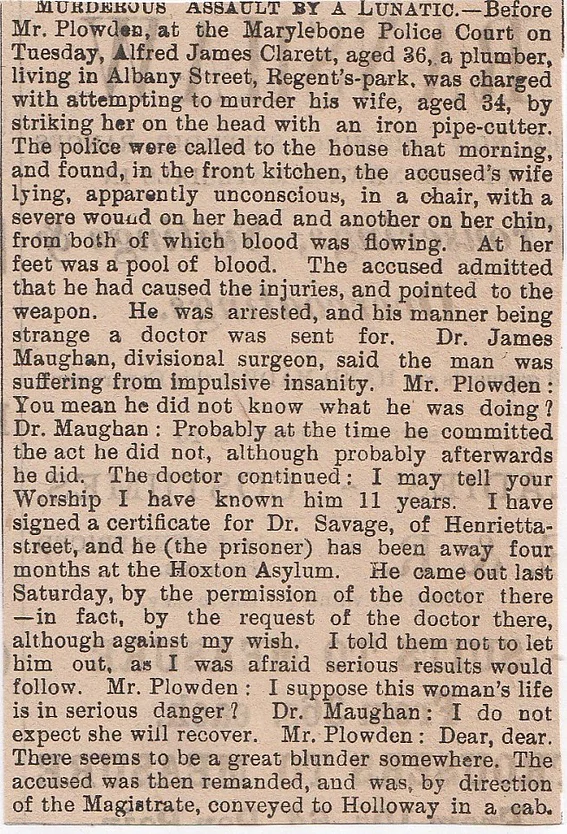
106/ Montagu Square, (Stable Death) July 1857 (North of Marble Arch)
Edwin Dupe, a coachman in Montagu Street, Montagu Square, was taking the horse to the stables when they reared up and appeared to be scared by something. He dragged the horse to the feeding trough where a large rat was feasting. The rat was the cause of the horses being afraid and agitated, so in his infinite wisdom, Dupe tried to kill the rodent. The rat dodged and weaved and finally landed on a horses back, which made it rear up on its hind legs, knocking Dupe over in the process. Dupes jaw was shattered to pieces and even hospital treatment could not save the life of him. He left a widow and six children.
107/ Crown and Sceptre Suicide, Great Titchfield Street, May 1847
Frederick Cruso, the landlord of the Crown and Sceptre pub, ended his life by swallowing some prussic acid. Recently he had become addicted to gambling on the horses and his own business had gone downhill as a result. He had told his missus quite recently, that he wanted to die and asked her to get some charcoal so that they could all die together, the children as well. The last Derby, he lost a hell of a lot of cash and when asked to pay his betting tab, he was unable to pay it. Cruso left home one morning and came back, then went up to his bedroom. It was on the floor in that room, she discovered his dead corpse.
108/ Marylebone Fatal Accident, April 1899
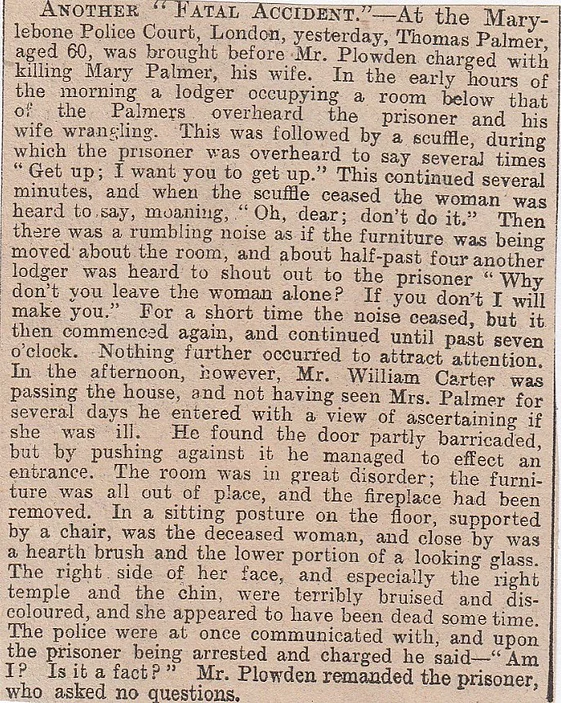
109/ Upper Charlton Street, (Alcoholic’s Acid Suicide) November 1862
Barbara Dent aged thirty-three, committed suicide at No 22, Upper Charlton Street, Fitzroy Square, by drinking sulphuric acid or oil of vitriol. The husband, Robert, identified his wife and said she had become addicted to drinking of late and was always on a downer when she did drink, and on one of these binges, she threatened to slit her throat. He went to her aunts about a week ago and saw her down four glasses of alcohol, then pull out a hip-flask with gin in it and said she have one more drink. When a doctor was called to see her, she was vomiting and her lips were scorched with the burning of the oil of vitriol. Dent was obviously insane and died shortly afterwards.
110/ Bond Street Station, (Accident or Suicide?) August 1901
A train bound for Shepherd’s Bush was stopped when pulling out of Bond Street Station. Workmen removed the front plank of that end of the platform and found a man in a huddled position between the engine wheels and the platform wall. He had been terribly mutilated, with cuts to his face, his skull fractured and his right leg severed off and his left foot also cut off. He was still alive, but only just and was rushed to Middlesex Hospital, but expired when he got there. Who he is, is not yet known.
111/ Piccadilly Fatal Accident, August 1896

112/ Whitehall Human Remains Discovered, October 1888
The inquest on the human remains discovered at Whitehall a week ago, say that the head had been sawn from the trunk, as well as the pelvis and lower portion of the body. The arms had been removed with great skill and dexterity and with a medical instrument. The parts missing from the victims of the “Whitechapel Murders”, are also missing from the trunk. An arm found in Pimlico on September the 11th, fitted the trunk exactly.
Later on, information came through that the woman’s trunk was found in the new police buildings in Whitehall. A police sniffer dog found another leg, which had been severed below the knee and a piece of material thought to be a stocking, was left on the limb. Police had supposed to have thoroughly searched the area, when the body was found, but the dog found the leg about five feet from where the trunk was discovered.
113/ Compton Street, Soho, October 1894 (Priests Body Found)
The body of a man thought to be Spanish and wearing priest’s garb, was found hanging to the bed-post in a house in Compton Street, Soho. He had rented a room with a companion. The remains are badly decayed and as he paid all his accounts last week, it is thought it could be from that time. The companion is at present, missing.
He was identified as Louis Caceres, a fifty-year-old Spanish priest and the companion was called Eugene, and they both arrived about three weeks ago. Eugene has disappeared off the face of the earth. Caceres hung himself with a silk handkerchief and by his side was a revolver and a letter addressed to the Chief of Police. The letter said he was disgusted with his own family and that he was tired of life. He also stated that he was a Peruvian national. The autopsy revealed he had been hanging in the room for at least three days, and the elusive Eugene is still evading the police radar.
114/ Edinburgh Mansions, (Murder/Suicide) July 23rd, 1885
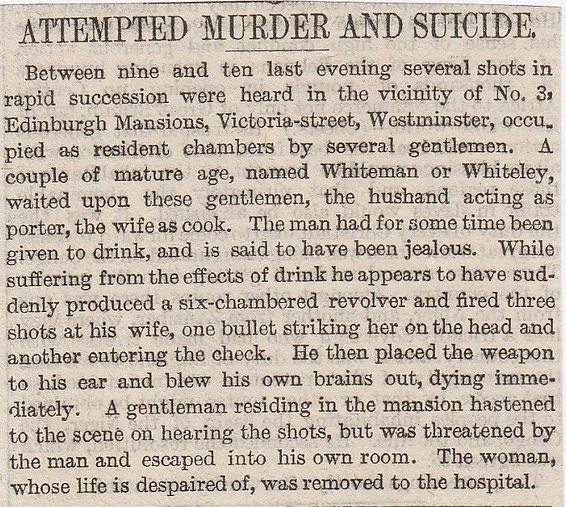
115/ Edinburgh Mansions, July 27th, 1885

116/ Duke of Yorks Column Suicide, May 1850
Albert Stephan, the saxhorn player at Her Majesty’s Theatre committed self-destruction by jumping off the Duke of York’s Column which is just off The Mall. He paid his six-pence to go up and see the view from the top and was looking around for about twenty minutes or so, then when he was virtually all alone and straight after the Horse-Guards clock struck 10-30, a woman was heard to scream. The attendant went to see what was wrong and just as he was about to climb the stairs, when he spotted the man’s body sprawled out on the stone pavement. He came down feet first and when his feet impacted with the ground, his boots burst from their soles and smashed his feet. He had some loose change on him, a handkerchief with the initials “S.T.” on it. He was single and in his fifties. (He landed on the west side, facing Carlton Gardens/Carlton Terrace)
117/ Wellington Barracks Murder? August 1890 (Near Buckingham Palace)
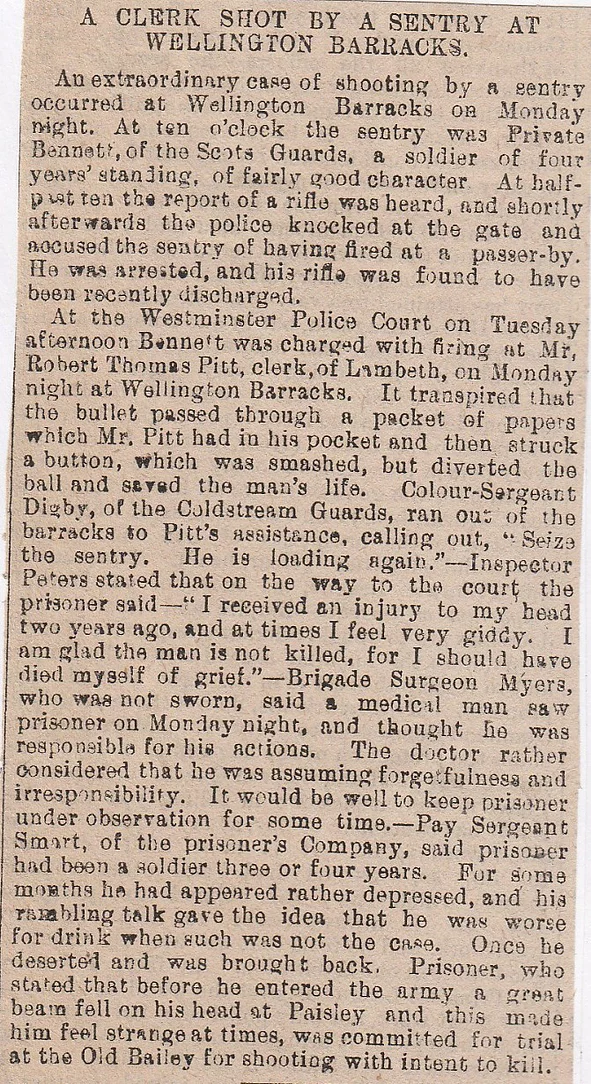
118/ Great Pulteney Street, Soho, March 1871 (Double Suicide)
At first, this considered to be a murder/suicide but was later revealed to be a double suicide instead. Mr Longnon of 27, Great Pulteney Street in Soho and his wife died from self-inflicted gunshot wounds, with her putting the gun in her mouth and firing, then he pointed it into his chest and shot himself in the heart. This can be certain as a neighbour heard a noise from the back room first, which is where she was found, then the front room, which is where Mr Longnon was. He had a letter on him, asking that the mother-in-law take care of the children, but as to the reason for the double suicide as yet nobody knows.
119/ Queen Street, Soho, (Child’s Mystery Death) September 1885
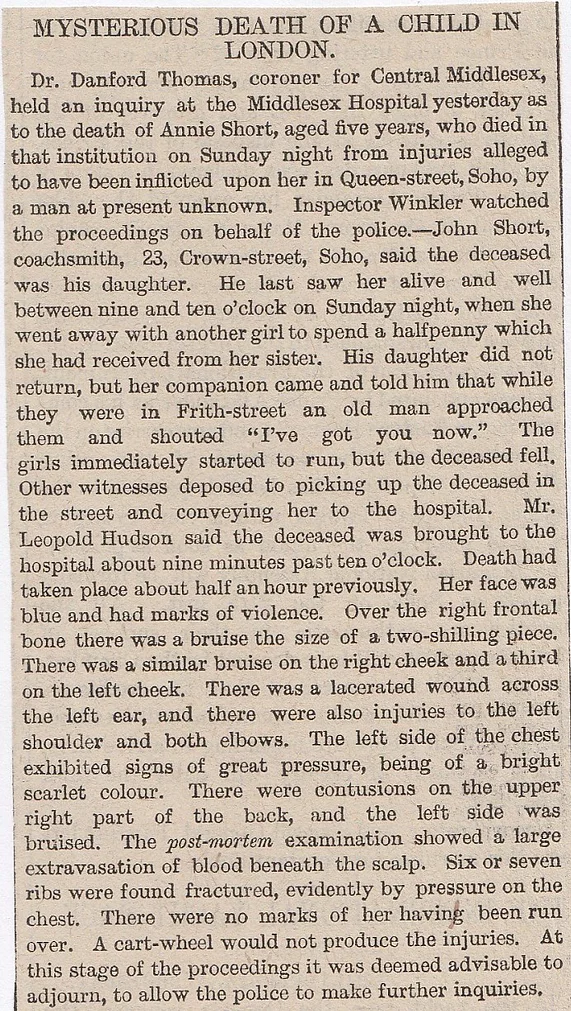
120/ St Martin’s Hall, Long Acre, (Four Deaths) January 1862
A catastrophic accident at St Martins Hall, Long Acre has resulted in two deaths and more are expected.Tthe Hall burned down in 1860 and has been rebuilt, and Mr DeFries was the contractor in charge of operations at present. Seven of his men were fitting a chandelier to the ceiling and they were stood on a plank in order to get up there. In today’s world with health and safety officials round every corner, they would have been shut down immediately, as in most Victorian operations, that involved people balancing on bits of wood etc. I think you can guess where this going! The cross poles which held up the plank suddenly gave way under the strain and they were thrown forty feet down on to the floor below. The problem in the Victorian era was that word got around very quickly and a large crowd had then gathered outside the Hall to see the dead and injured. Patrick Coglan died in hospital, as did a chap by the name of Wood. Two others died during the night, making four deaths and the other three are in a dangerous condition and may not make it. (How many died in the accident?)
121/ Pimlico, (Barrister’s Wife Death) August 1890
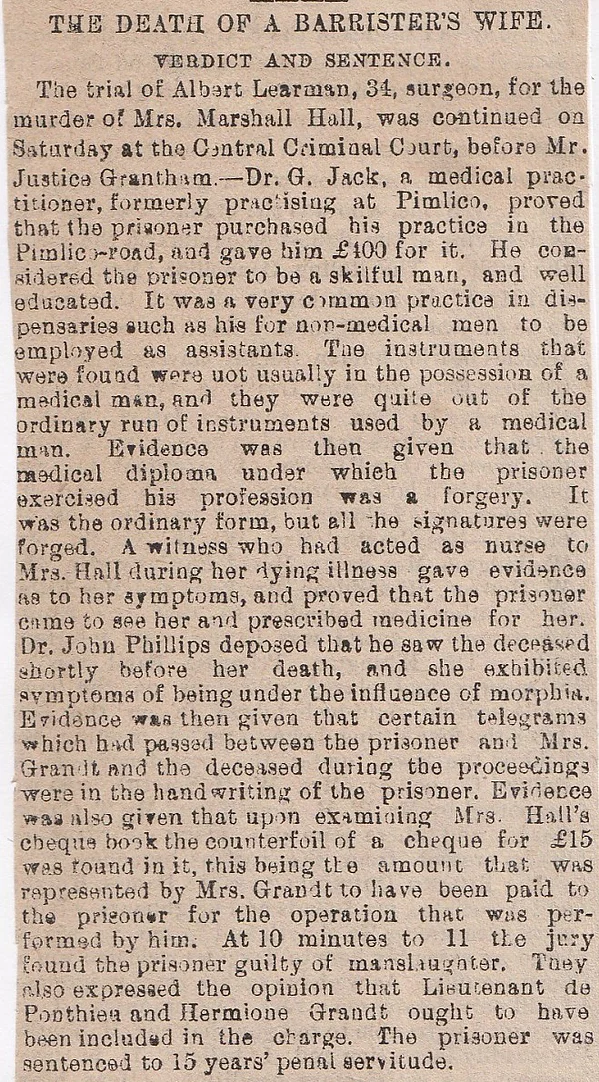
122/ Tottenham Court Road Mystery, March 1899

123/ Holles Street Fire, Clare Market, January 1885
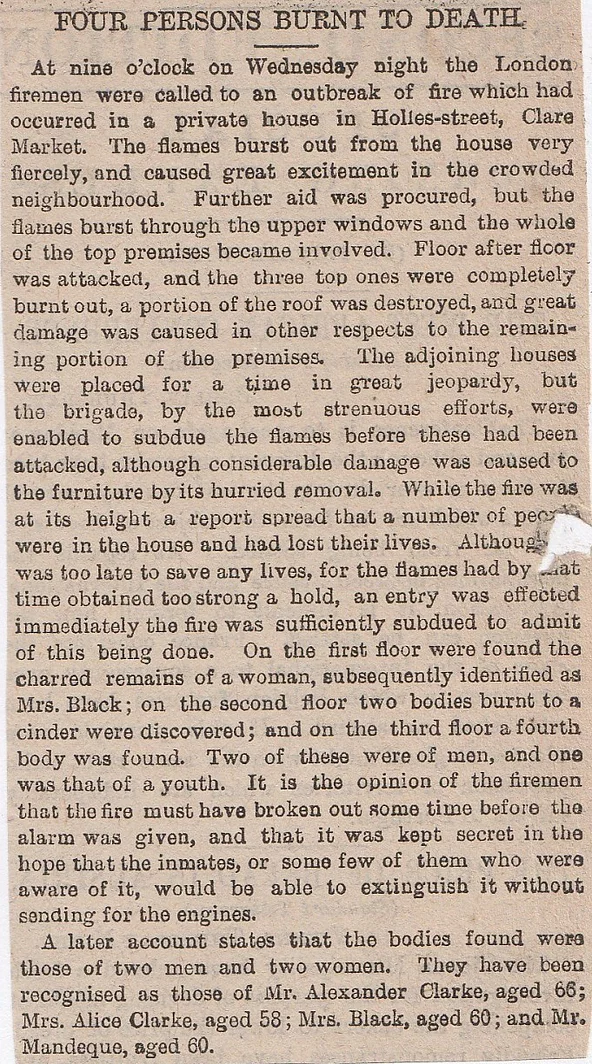
124/ Horse Guards, January 1916 (Lt-Colonel Suicide)
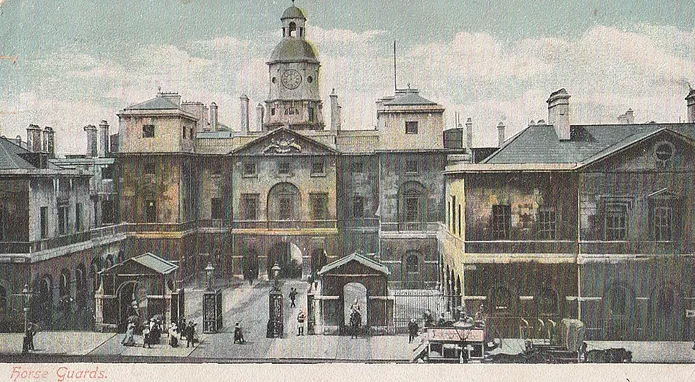
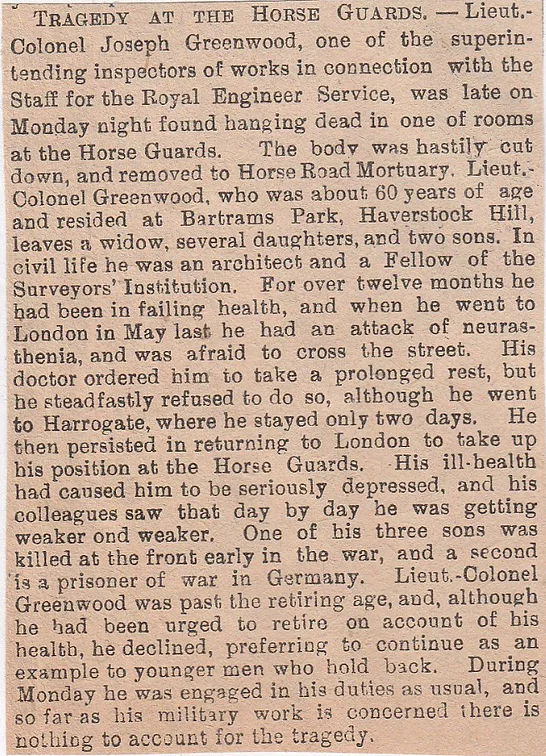
125/ Westbourne Street, Pimlico, October 8th, 1885 (Father Manslaughter)
A letter carrier named Charles Goulding, who resided in Westbourne Street, Pimlico, met with his death under peculiarly shocking circumstances yesterday. Just as he was finishing his dinner, his son Joseph aged thirteen provoked him and on a sudden impulse, he threw a plate and knife at the boy. The boy, in retaliation, picked up the knife and stabbed his father in the thigh, severing the femoral artery and the unfortunate man expired in a short time. The boy was apprehended at Waltham Green.
126/ Westbourne Street Parricide, Pimlico, October 13th, 1885
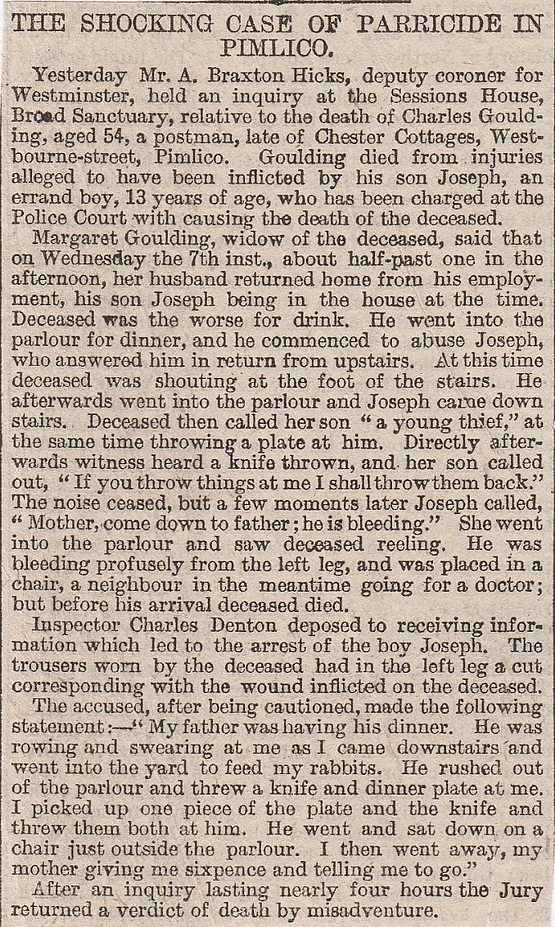
127/ Upper Bond Street, Mayfair, (Love Tragedy) May 1899
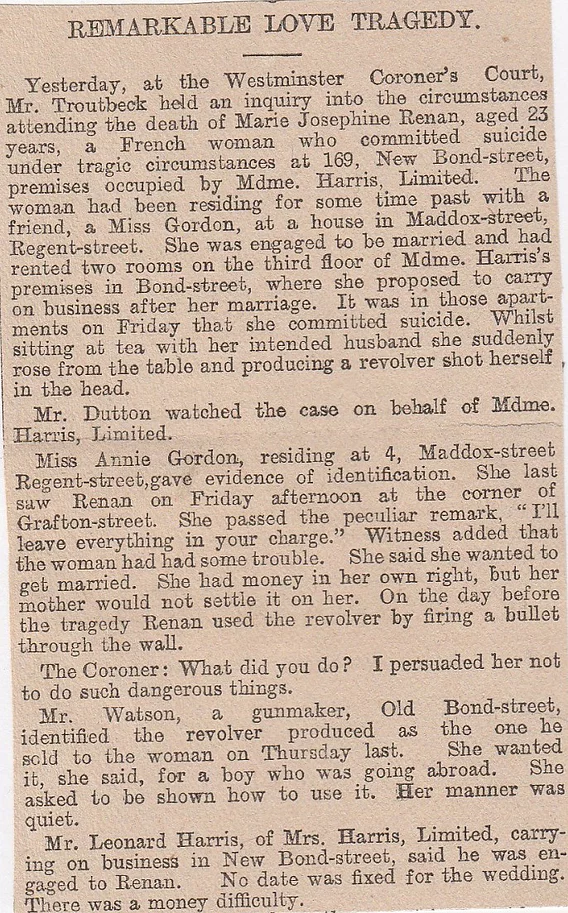
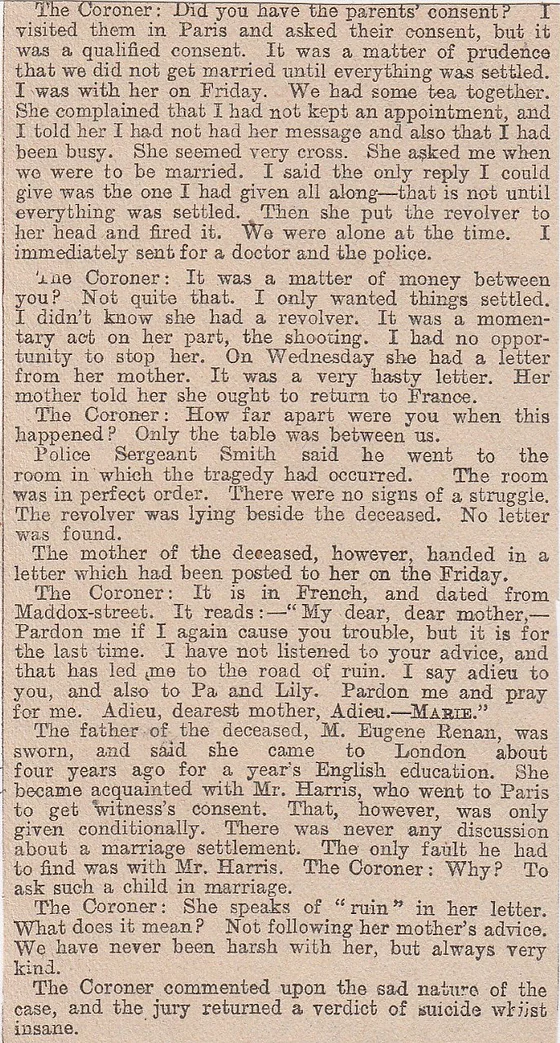
128/ No 50, Strand, (London Mystery) December 1885

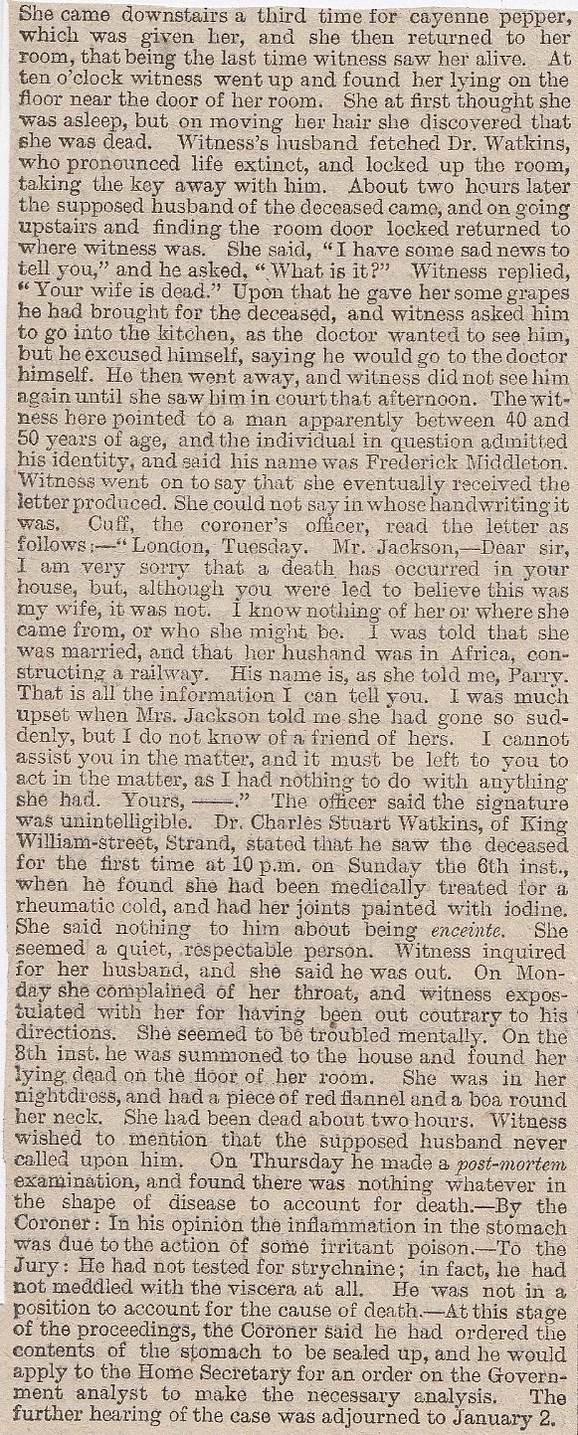
129/ National Portrait Gallery Murder/Suicide, Trafalgar Square, February 1909
A murder/suicide in a national museum is an unusual occurrence, but it happened at the National Portrait Gallery in Trafalgar Square. The victim and murderer are Mr and Mrs John Tempest Dawson who resided at 31, Brunswick Place, at Hove near Brighton. It happened in Room 27, in the east end of the gallery, which fronts onto the church of St-Martins-in-the-Fields. They entered the gallery at around 2-30 p.m. when it was a bit sparse with customers, and when John shot his missus there were only two young lasses stood in the vicinity. They were Miss Saybine and Miss Gladman, who saw him whip out a revolver and shot his partner point blank in her temple. She dropped to the floor with a pool of blood trickling from her head, then he put the gun in his mouth and pulled the trigger. With the sound of gunfire, it was panic stations. An attendant ran to Mrs Dawson, who amazingly was still breathing, but unconscious. They tried to revive her but she died at Charing Cross Hospital a couple of hours later. John Dawson had a great deal of money on his person and some gold, along with his gold ring and watch. It would seem that they were extremely well-to-do. A letter also found would indicate that the whole act was premeditated and it was written on a typewriter, with certain lines mentioning that he was being blackmailed and that he couldn’t take it any longer, and his friends had now found out about it. The gallery officials closed the room in which the murder and suicide were committed, until further notice. There was no fighting or arguing before the fatal shots were fired, so the motive for his actions are as yet unclear. Their address in Hove was a boarding house in Brunswick Place and they had lived there for about a decade or more.
130/ Edgware Road Fire Deaths, June 9th, 1888
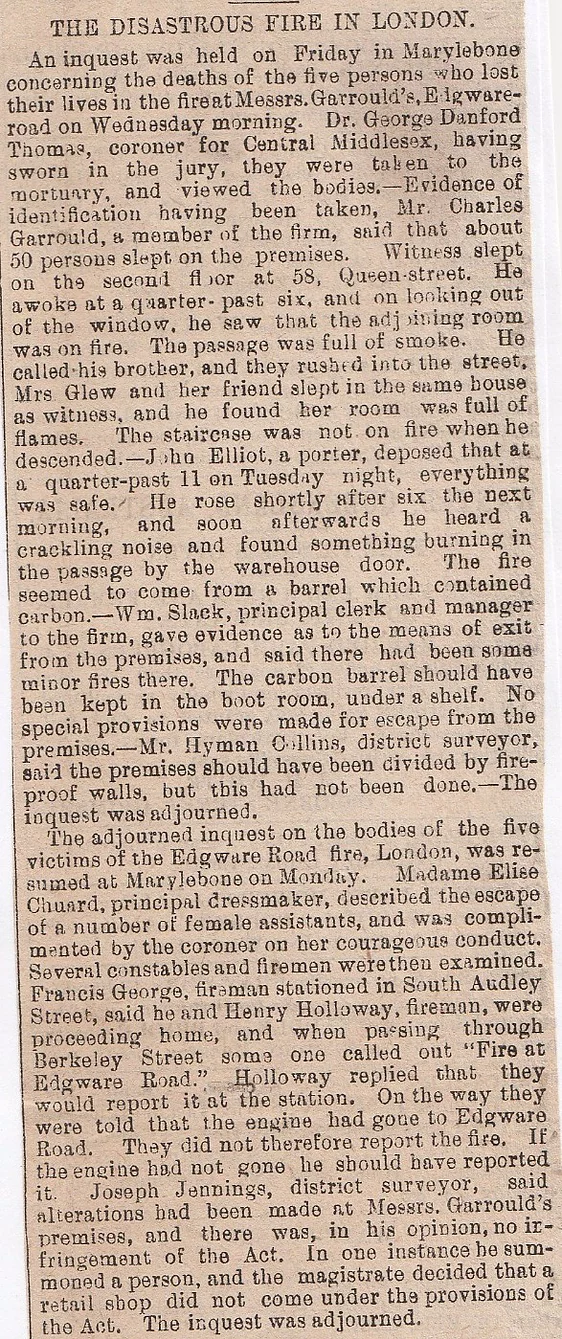
131/ Cornwall Terrace Suicide, Regent’s Park, June 1863
The butler to Valentine Knight Esq., a magistrate, has hung himself in the pantry of the gentleman’s property. Thirty-year-old William Richards had been in his employ for a few months and was well-liked by all in sundry. When the cook found a note on the pantry door one morning, with “you better get a policeman to cut me down, as you will find me dead inside”, written on it she became nervous of what was about to meet her gaze. A policeman was summoned and the door was forced open and sure enough, inside was Richards hanging with a fourteen-pound weight in one hand. There were several letters found and one thanked his master for being so kind to him, plus a £10 note for Young Men’s Christian Society, to help the poor in Brighton. His shady past had come back to haunt him as he committed a robbery at Brighton some time ago and was banged up for three months and this preyed on his mind. He wrote down that he only did the robbery to see how well he could do it.
132/ Drury Lane Murder, April 1899
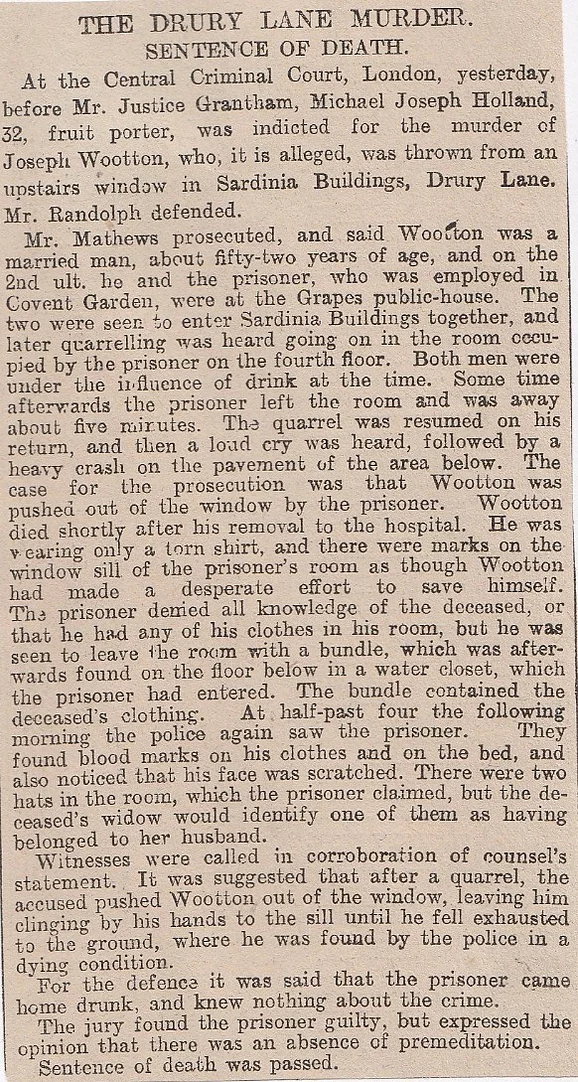
133/ Drury Lane Murder, April 25th, 1899
Joseph Holland, condemned to death at the Old Bailey for the murder of a man named Wootton, by throwing him out of a window near Drury Lane, has presented a petition to the Home Secretary praying for commutation of the sentence. He urged that the occurrence was the outcome of a drunken brawl and that he had no intention of taking life. The execution is fixed for a week today.
134/ Grosvenor Road Station Fatality August 1870 (Just below Victoria Station, near Thames, Grosvenor Road)
135/ Bloomfield Square Fatal Fight July 1870
136/ Regent Circus Omnibus Accident, August 1870
Last evening Mr Bedford held an inquest at St James’s Workhouse, Poland St, on the body of William Arnold, aged 56, for many years the manager to Messrs. Stagg and Mantle, linen-drapers, in Leicester Square. On Sunday evening the deceased, who was in company with his brother, was getting down from the outside of an omnibus at the corner of Regent Circus when his foot slipped on the first step, and he fell headlong and with great violence to the pavement. He was picked up insensible and conveyed to his brother’s residence at 349, Oxford St. when a medical man was sent for. The deceased remained in a semi-conscious state until Tuesday evening last, when he died. Medical evidence suggests he died from a fracture of the skull, a broken right collar-bone, and several fractured ribs, with one of the bones having penetrated the upper part of the lungs. It appeared the omnibus was stationary at the time of the accident. “Accidental Death” was returned.

